QUEER ICON KEVIN AVIANCE IS HAVING THE COMEBACK OF HIS LIFE

8 NEW QUEER MOVIES COMING OUT THAT WE CAN’T WAIT TO SEE
GETTING TO KNOW SUGAR HIGH’S ADAM FOX
WHY YOU NEED TO ADD POP-COUNTRY QUEER ICON CMAT TO YOUR 2023 PLAYLISTS
1 CELEBRATING CANADA’S LGBTQ2 COMMUNITY JANUARY / FEBRUARY 2023
- FROM EVERYONE AT IN MAGAZINE - FROM EVERYONE AT IN MAGAZINE
- FROM EVERYONE AT IN MAGAZINE
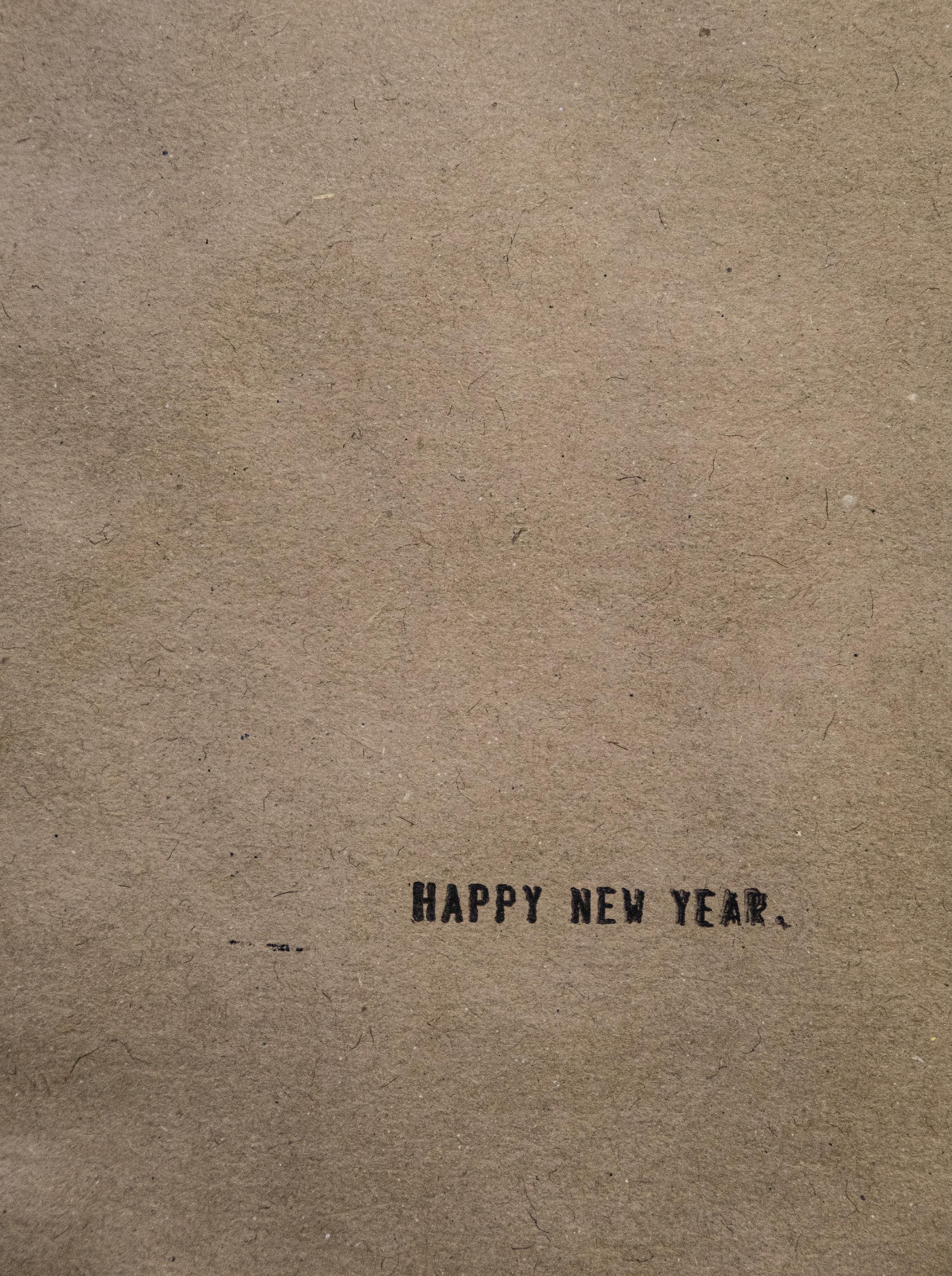




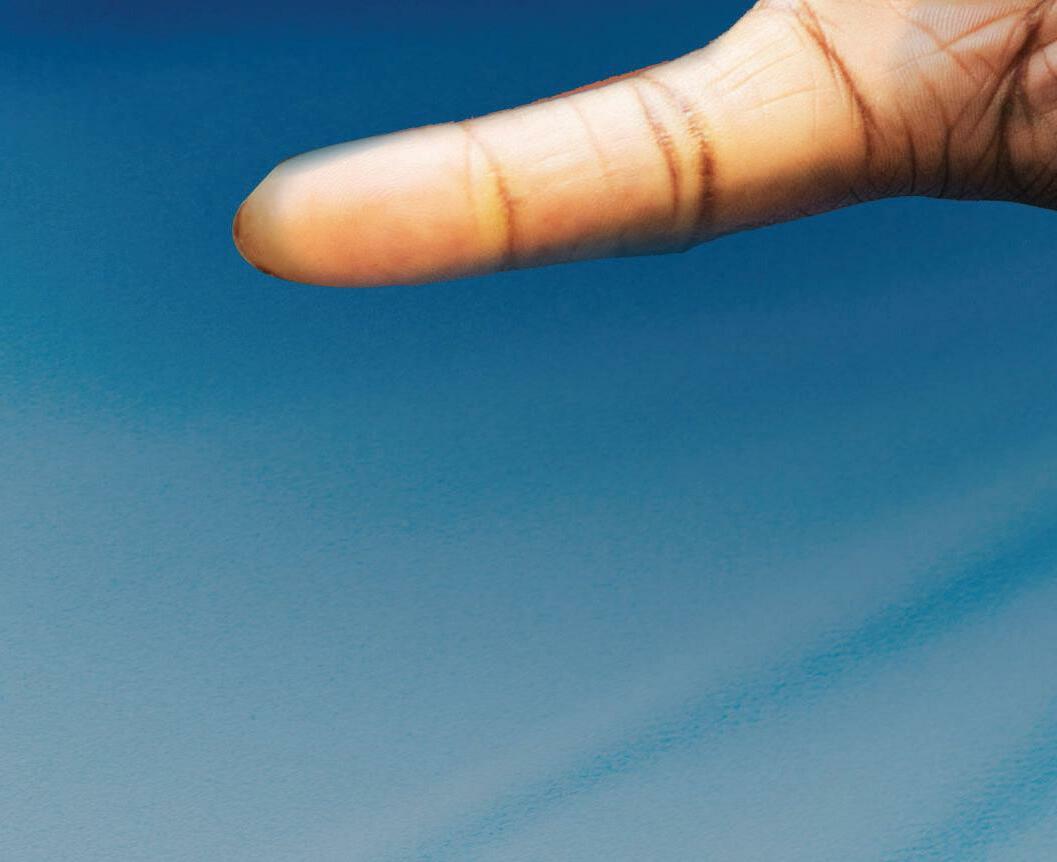


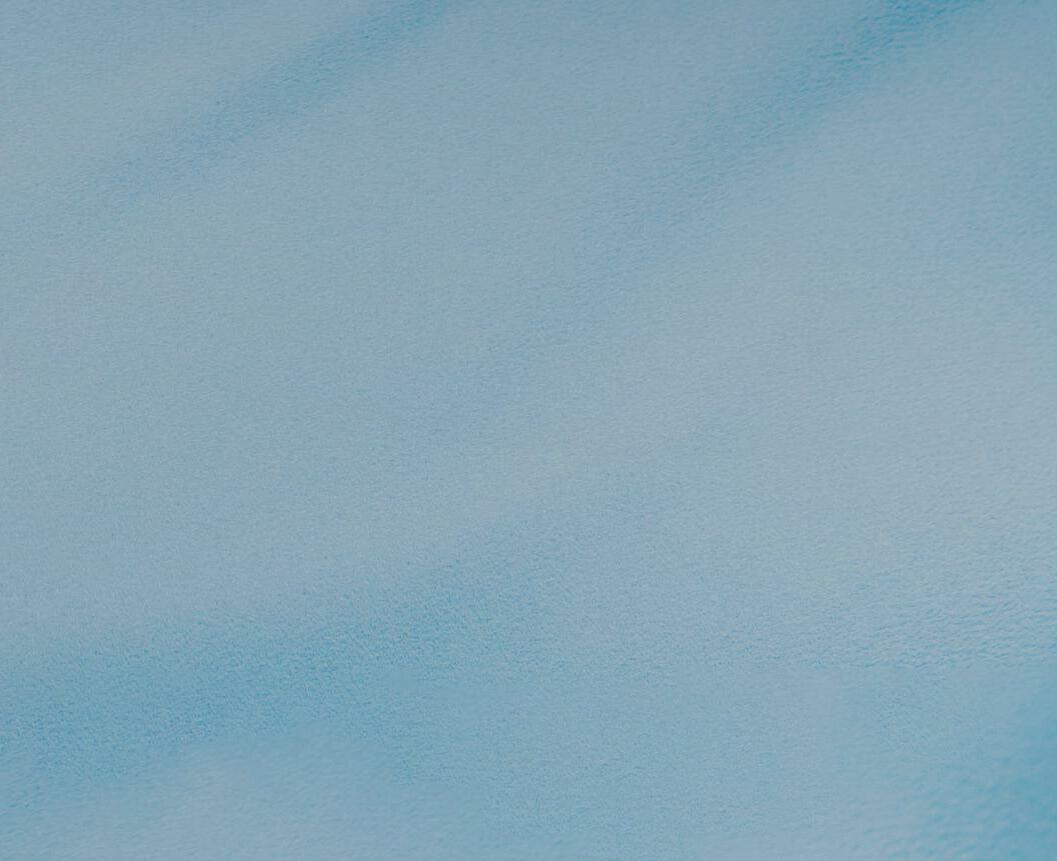


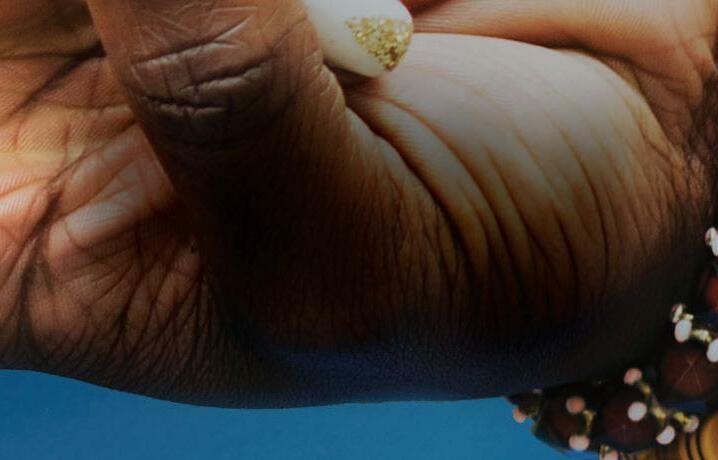
Talk to your doctor about your HIV treatment options MyHIVTreatmentOptions.ca Stock photo. Posed by model. Brought to you by one of Canada’s leading research-based pharmaceutical companies. Code: PM-CA-HVX-JRNA-220001-E Date: 08-2022 There is more to life than viral suppression YOU HIV
inmagazine.ca
PUBLISHER
Patricia Salib
GUEST EDITOR
Christopher Turner
ART DIRECTOR
Georges Sarkis
COPY EDITOR
Ruth Hanley
SENIOR COLUMNISTS
Paul Gallant, Doug Wallace
CONTRIBUTORS
Jesse Boland, Tyler Boyce, Matthew Creith, Adriana Ermter, Courtney Hardwick, Noel Hoffman, Elio Iannacci, Karen Kwan, Luis Augusto Nobre, Rowan O’Brien, Ivan Otis, Brian Phillips, Casey Williams

DIRECTOR
Benjamin Chafe
DIRECTOR OF COMMUNICATIONS AND COMMUNITY ENGAGEMENT
Jumol Royes
COMMUNITY ENGAGEMENT MANAGER
Tyra Blizzard
CONTROLLER
Jackie Zhao ON
ADVERTISING & OTHER INQUIRIES (416) 800-4449 ext 100 info@inmagazine.ca
EDITORIAL INQUIRIES (416) 800-4449 ext 201 editor@inmagazine.ca
4 IN MAGAZINE JANUARY / FEBRUARY 2023
Magazine is published six times per year by Elevate Media Group (https://elevatemediagroup.co). All rights reserved. Visit www.inmagazine.ca daily for LGBTQ2+ content.
John St, Suite #509, Toronto, Ontario, M5T 1X5
IN
180
OF BUSINESS DEVELOPMENT
THE COVER: KEVIN AVIANCE
PHOTOGRAPHY
PHOTO BY THOMAS EVANS
WWW.THOMASEVANSPHOTOGRAPHY.COM @THOMASEVANSPHOTOGRAPHY
Issue 110
January | February 2023
INFRONT
06 | COLOURING THE BLANK PAGES
Only you can find the strategy that best suits your path and pace towards the best version of yourself
08 | YOUR BEST WINTER ACCESSORY: SUNSCREEN
Hydrating and protecting your skin this season is 100 per cent possible and necessary
10 | FRESH STARTS
Tap into that extra motivation you’ve got kicking off this new year and live your life a little bit better
11 | BE AN ALLY FOR PEOPLE LIVING WITH HIV THIS NEW YEAR
We talk to activist Christian Hui and Dr. Mona Loutfy about how Canadians can be allies and support the community of those who are living with HIV

12 | LEARN THE FOREIGN LANGUAGE OF ELECTRIC VEHICLES
Electric vehicles (EV) run on electricity alone. Here’s everything else that you need to know
13 | TAKING COLLECTIVE ACTION TO COMBAT HATE CRIMES
Canada’s largest 2SLGBTQI+ network is leading communities in the drive to do what we have always done – take care of one another
FEATURES
14 | WHEN I GROW UP, I WANT TO BE A LIGHTWORKER
When we shine our own light, we empower others to light up, too
16 | ROBERT WATSON IS ALL ABOUT QUEER JOY
We talked to the Toronto comedian about hosting Gay AF, his new comedy album and what’s next for him
18 | DO GAY PEOPLE ACTUALLY KNOW HOW TO TALK: AN INVESTIGATION
Do we truly understand the slang we use, or are we simply regurgitating what we’ve seen online?
20 | 8 NEW QUEER MOVIES COMING OUT IN 2023 THAT WE CAN’T WAIT TO SEE Here are some of the films that you just have to see this year
22 | I LOVE THE WAY YOUR FOUL LITTLE MIND WORKS: THE QUEER ICONOGRAPHY OF CINEMATIC VILLAINS
How the LGBTQ+ community has reclaimed queer-coded villains
24 | YEAR OF THE AVIANCE Queer icon Kevin Aviance on his extraordinary past and epic future
30 | WHY YOU NEED TO ADD CMAT TO YOUR 2023 PLAYLISTS
Irish teen pop sensation has taken the world by storm with her beautiful vocals and witty lyricism
32 | GETTING TO KNOW SUGAR HIGH’S ADAM FOX
We sit down with the openly gay actor to chat about coming out, role models, his first acting gig, the upcoming TV show, and much more
46 | THE BOOKS THAT HELPED ME FIGURE OUT MODERN QUEER LIFE
A list of books that helped shape my ideas about LGBTQ2+ culture, desires and life
48 | PARTY HEART-Y AT WORLDPRIDE SYDNEY!
Sydney hosts WorldPride 2023 with a full week of fun-in-the-sun events

50 | EXCLUSIVE IN PAPAGAYO
A deluxe experience in northern Costa Rica reveals Pacific vistas, detailed hospitality and wide-open wilderness
54 | FLASHBACK: FEBRUARY 29, 1988 IN LGBTQ+ HISTORY
Svend Robinson becomes Canada’s first Member Of Parliament to come out as gay
FASHION
36 | SHOW ME… PORTRAIT SERIES
We asked everyone to come in their own clothes
5 110
THIS ISSUE OF IN MAGAZINE IS BROUGHT TO YOU BY
A total of 16 fierce queens will battle it out on RuPaul’s Drag Race season 15, which will feature the 200th episode in the series. Follow IN’s weekly episode recaps on inmagazine.ca kicking off with the premiere episode, which airs on Friday, January 6 (Photo: MTV/World of Wonder)
Colouring Blank The
Pages
 By Luis Augusto Nobre
By Luis Augusto Nobre
6 IN MAGAZINE JANUARY / FEBRUARY 2023 PRIDE AT WORK
Only you can find the strategy that best suits your path and pace towards the best version of yourself
Photo by Brandi Redd on Unsplash
It doesn’t matter which year we are in; every single January, I hear my friends, family and colleagues (oops…myself as well) sharing goals and expectations to be realized in the brand new year in front of us. It is the perfect time to celebrate 365 days of new opportunities, like blank pages waiting to be filled with words, drawings and colours. There’s the excitement of the unknown and how we can explore those adventures of just living our dreams.
One thing I decided for 2023 (and it could be a common milestone for many of us): I want to continue my journey of living and celebrating my authentic self. I know some people around me who have been seeking something similar, but they are afraid of trying it. I am aware that it isn’t an easy decision, as we might need to show more of our vulnerabilities and imperfections.
Although facts are really important to endorse our decisions, I do like to use some non-concrete approaches to expand my mind to visualize new angles and inspirations. For example, a curiosity about 2023 is that the sum of its numbers is seven, and one of the meanings of that number in numerology is plenitude. It could be a year for us to reflect on our wishes and desires and to move in the direction of making them come true. We would fulfill our souls and hearts with everything that creates the best version of ourselves. We could live better because the sense of accomplishment is felt from different perspectives as we open ourselves to who we are.
To ground us in this self-knowledge journey, we should also have in mind that another meaning to the number seven is perfection. Many of us have the goal and challenge in life of being perfect in everything that we do, and then experience the impostor syndrome as it is so hard to maintain those standards. However, the path to achieving this perfection level is more important than its actual achievement. We have to learn how to be perfect with our own imperfections and use them to understand that we aren’t any better than anyone else. For something specific, we might be, but in the end, we are equivalent to each other. This is the secret.
Using other meanings from numerology to get inspired, we can break down the number seven into different combinations, but I like the combination of the creativity from number three and the practicality from number four. This special sum could take us to the path of a life free of obstacles because we will have several and imaginative perspectives about who we truly are and what we really need. Different solutions to our own problems when we open our minds.
This piece could be one of my attempts to use the combination above. I can see and interpret my own words to guide me on this path of rethinking my imperfect writing and to look for new understandings. I revise my vulnerabilities while I show them to you, and I can apply this opportunity to build my self-knowledge towards my authentic self. It is cyclic, as I will keep repeating all the same steps in an upward spiral every time I read it. It might be the same for you, or it might take you to link my words with other content on your path.
I want to continue writing about who I am and who I want to be in those blank-page opportunities called days in front of me. They will take me to look into the mirror with my questions and my
answers. They will allow me to see my beauty and my ugliness, my strength and my weakness, my heart and my soul. Regardless of what will happen to me, I am not afraid but conscious of trying to live my authentic life as well as I recognize being defeated in my expectations. I have to maintain a healthy balance of what is possible with the current tools and skills.
You cannot be sure that using my shared strategies and suggestions will help you to find and celebrate your authentic selves. It would be too pretentious to assume that these words are any kind of checklist to an individual journey; we need to consider our own baggage and lived experiences. Only you can find what strategy best suits your path and pace towards the best version of yourself. Hopefully, my thoughts will inspire you to be adventurous and find out.
If I can wish something for you in this new year, I hope you can find your way to live without fear of showing others who you are, and celebrate yourself wherever you are (if it is safe). I am still learning, but I see how many steps I took and the challenges I have faced. It hasn’t been easy, but I am not afraid or ashamed anymore when I share in any environment that I am a queer man. Queer and proud.
The new year is just starting. See it as an opportunity to celebrate you. Take the chance to make the impossible possible. If you feel fear, move on with the fear. Many times, it protects you, but don’t let it paralyze you. Your capacity to overcome all the challenges should be bigger than the fear of living your authentic self. Celebrate you. Write your destiny. Draw and colour your dreams. Live the best version of yourself, because you are awesome and deserve the happiness of just being who you are.
And hey…have a wonderful and colourful new year, as every day is a new cycle beginning in front of us.
7 LUIS AUGUSTO NOBRE is the communications coordinator of Pride at Work Canada/Fierté au travail Canada, a leading national non-profit organization that promotes workplace inclusion on the grounds of gender expression, gender identity and sexual orientation. For more information, visit prideatwork.ca. PRIDE AT WORK
“
If I can wish something for you in this new year, I hope you can find your way to live without fear of showing others who you are, and celebrate yourself wherever you are (if it is safe).”
Your Best Winter Accessory:
Sunscreen
Hydrating and protecting your skin this season is 100 per cent possible and necessary
 By Adriana Ermter
By Adriana Ermter
‘Sun care, do care’ is skincare’s most important motto, 365 days a year. And, yup, that means wearing a layer of SPF protection during winter’s cold and frosty months. “People think because it’s cold outside that we don’t need to protect our skin from the sun,” explains Dr. Lisa Kellett, a dermatologist and the founder of DLK Cosmetic Dermatology and Laser Clinic in Toronto. “But you can tan and burn when you’re outside in the winter. The sun’s UV rays, especially UVA rays, can penetrate clouds and glass too.”
Why screen in the winter
While it’s true that winter sun tends to be less intense than summer sun, its UVA (think aging) and UVB (think burning) rays are still present. In fact, although UVB radiation does decrease slightly during the cold season, UVA radiation remains the same in any given location no matter what the season. Their impact is sneaky too, as the crisp, cooler weather often makes the sun’s rays feel deceptively less intense, particularly when outdoor temperatures can have you shivering beneath bundles of layers. Factor in ice and snow’s capacity to reflect and bounce light off the ground and back onto exposed skin, and winter sun damage is very real.
8 IN MAGAZINE JANUARY / FEBRUARY 2023
LOOKING GOOD
Photo by Joe Yates on Unsplash
“Anything the light can bounce off of, it will,” affirms Dr. Nowell Solish, a dermatologic surgeon, assistant professor at the University of Toronto, co-director of the Non-Melanoma Skin Cancer clinic at Women’s College Hospital, and founder and owner of his eponymous dermatology clinic in Toronto. “Unlike grass and dirt, which absorb the sun’s rays, during the winter light is scattered and then reflected back off of water, snow and ice, so it’s a double whammy of exposure for your skin.”
Impact of sun exposure
Exposure can cause skin cancer. According to the Canadian Skin Cancer Foundation, skin cancer is the most common type of cancer for both women and men, with more than 80,000 cases diagnosed in Canada each year – 5,000 of which are melanoma, the deadliest form of skin cancer. Additionally, the Canadian Cancer Society estimated that in 2022 alone, 4,900 men and 4,000 women would be diagnosed with melanoma skin cancer that would result in 1,200 deaths. “UVB damages skin cells and causes DNA mutations that can eventually lead to melanoma and other types of non-melanoma skin cancer,” affirms Dr. Julia Carroll, a board-certified dermatologist at Compass Dermatology in Toronto.
As dangerous as sun exposure is, though, Dr. Carroll says cancer isn’t its only consequence. The appearance of fine lines, crow’s feet and wrinkles, the sagging and leathering of skin, as well as freckles, discolouration, sunspots and even broken blood vessels are also the result of sun exposure. “UVA radiation makes up 95 per cent of the ultraviolet radiation that makes it to the earth’s surface, and damage from UVA results in a tan,” says Dr. Carroll. “It is the primary form of radiation used in a tanning bed and causes skin aging, including wrinkles. UVB ray exposure makes up only five per cent of the UV rays from the sun. It does not penetrate as deeply as UVA, but it too can cause significant damage to the top layers of the skin.”
Why sunscreen works
Sunscreen can help reduce and prevent this impact when used year-round and on a consistent and daily basis. Sunscreens like Sun Bum Moisturizing Sunscreen Lotion SPF 30 ($21, available online at www.well.ca) and Aveeno Protect and Hydrate Face and Body Sunscreen SPF 30 ($18, available at Shoppers Drug Mart) can be swapped in for, and even replace, daytime moisturizers, as many include hydrating ingredients such as glycerin, ceramides and water to keep skin soft, supple and smooth.
When applying to your face, “just make sure your face is clean and that you apply a dime-sized amount,” adds Dr. Solish. “The ingredients in your sunscreen need to be absorbed into your epidermis [the outer, top layer of your skin] to do their job. If you need more hydration during winter’s drier months, you can always apply your regular eye and face creams and lotions over top of your sunscreen.”
Chemical vs physical
Choose a sunscreen that has a minimum SPF of 30 and provides broad-spectrum coverage to protect your skin from both UVA and UVB rays, be it a physical or a chemical-based product. “Technically, they’re all chemically based formulations,” says Dr. Kellett. “The difference is how they work.”
Physical (sometimes referred to as mineral) sunscreens like Sun Bum Mineral SPF 30 Tinted Sunscreen Face Lotion ($26, available online at www.well.ca) and Clinique Broad Spectrum SPF 50 Mineral Sunscreen Fluid for Face ($41, available at Hudson’s Bay) consist of active ingredients like zinc oxide or titanium dioxide, and sit on top of the skin to create a physical barrier that blocks the sun’s rays at the surface and reflects them away from the skin.
Chemical sunscreens like Neutrogena Ultra Sheer Dry-Touch SPF 30 Sunscreen ($18, available at Shoppers Drug Mart) and Clarins Dry Touch Facial Sunscreen SPF 30 ($34, available at Hudson’s Bay) are often mix-mastered with ingredients such as oxybenzone, avobenzone, octocrylene and octisalate, and absorb the sun’s rays like a sponge before converting them into heat, which is then released through the skin.
Rule of thumb: chemical sunscreens tend to work best for those prone to acne, as their formulations are thinner and noncomedogenic; mineral-based options are often gentler on sensitive skin.
Whether you choose a chemical or physical formulation, and regardless of the SPF number listed on the packaging, remember that these products are not meant to increase the amount of time you can spend in the sun; rather, they provide protection while you are exposed to the sun. “A sunscreen with a 60 SPF is not double the protection of one with a 30 SPF,” affirms Dr. Kellett. “The number is an indicator for how long it will take your skin to become red in the sun. Using a 30 SPF is a good base, and then reapply it regularly depending on how long you’re exposed to the sun.”
Safe screening
Recently, chemical sunscreens have faced criticism and have been said to have some adverse effects on the environment. In 2018, the Center for Biological Diversity, a US non-profit conservation organization, petitioned the US Food and Drug Administration for a national ban on the chemicals avobenzone, octocrylene, oxybenzone and octinoxate to protect marine and environmental health. Last year, the state senate in Hawaii passed a bill banning the use of the petrochemicals avobenzone and octocrylene to protect Hawaii’s coral reefs.
More research is required, and studies are continuously being conducted about the impact of these products, and about the possible absorption of certain sunscreen ingredients through the skin. To date, Health Canada stands behind the safety of all chemical sunscreens on drugstore shelves with a Drug Identification Number (DIN) and all mineral sunscreens listing a Natural Product Number (NPN). “The health risks of not wearing a sunscreen, or wearing one that has not been approved by Health Canada, far outweigh any other risk,” says Dr. Solish.
What about subbing out regular sunscreen products for newer SPF-infused facial powders? While these new products are a solid addition to your sunscreen regimen, they are not strong enough to stand alone against the sun, and are best paired with a broadspectrum sunscreen with SPF of 30.
As for the best sunscreen you can buy and wear, “it’s the one you use every single day,” says Dr. Kellett.
9
LOOKING GOOD ADRIANA ERMTER is a Toronto-based lifestyle-magazine pro who has travelled the globe writing about must-spritz fragrances, child poverty, beauty and grooming.
Fresh Starts
Tap into that extra motivation you’ve got kicking off this new year and live your life a little bit better
By Karen Kwan
Switch to sustainable gear
New Zealand’s outdoor apparel brand Kathmandu has just launched in Canada, and its NXT-Level jacket is both stylish and warm enough for our winters. Plus, it comes with a unique feature: it’s biodegradable. As part of Kathmandu’s commitment to fighting apparel waste, the jacket is designed to biodegrade in a biologically active landfill without oxygen. So, for example, after about 646 days, the synthetic fill biodegrades by 93.8 per cent. It’s a guiltfree winter wardrobe fix.
Go on a well-being streak
When it comes to fitness, it’s often pushed as “no pain, no gain.” But this full-out approach can be discouraging for some (and, worse, may lead to injury). Put your well-being first with the award-winning Gentler Streak app for your Apple Watch. Gentler Streak helps you find your personal balance between fitness and rest by recommending daily workouts that help you maintain your healthy activity levels.
Get your veggies
Including more greens (and the entire rainbow of vegetables) in your diet can be both simple and delicious. You can’t help but feel empowered to make a healthy change to your diet with the quick and nutritious plant-based meals in the new cookbook from Jeanine Donofrio: Love & Lemons: Simple Feel-Good Food: 125 Plant-Focused Meals to Enjoy Now or Make Ahead. From the Spring Pea Fritters with Whipped Feta to the Eggplant Sheet Pan Shawarma, these recipes are guaranteed to become part of your regular rotation.
Balance your day
To stay healthy, you should get up and move periodically throughout the day: 40 minutes is the amount of moderate to vigorous physical activity you need to do daily to balance out 10 hours of sitting still, according to a meta-analysis published by the British Journal of Sports Medicine. Here’s a simple way to remember that if you’re stuck at a desk during your workday: program a note in your calendar that beeps every hour to remind you to get up and stretch.
Sleep well
Adults need seven to nine hours of sleep a night. Here are three simple things you can try to improve your sleep routine: Add some plants to your bedroom: Certain plants can help you get a better night’s rest. Golden pothos, for example, are good for purifying the air in your bedroom as you snooze, while the scent of jasmine as you fall asleep has been shown to lead to more restful sleep.
Use a weighted blanket: A recent study conducted by researchers at Uppsala University in Sweden found that using a weighted blanket may result in more melatonin being released. Melatonin is a sleep-promoting hormone produced by the brain, which makes you less alert and makes you desire sleep.
Write down your to-do list for the next day when you go to bed: A study published in the Journal of Experimental Psychology found that those who spend five minutes writing this down fall asleep an average of nine minutes faster compared to those who wrote down what they’d accomplished that day.
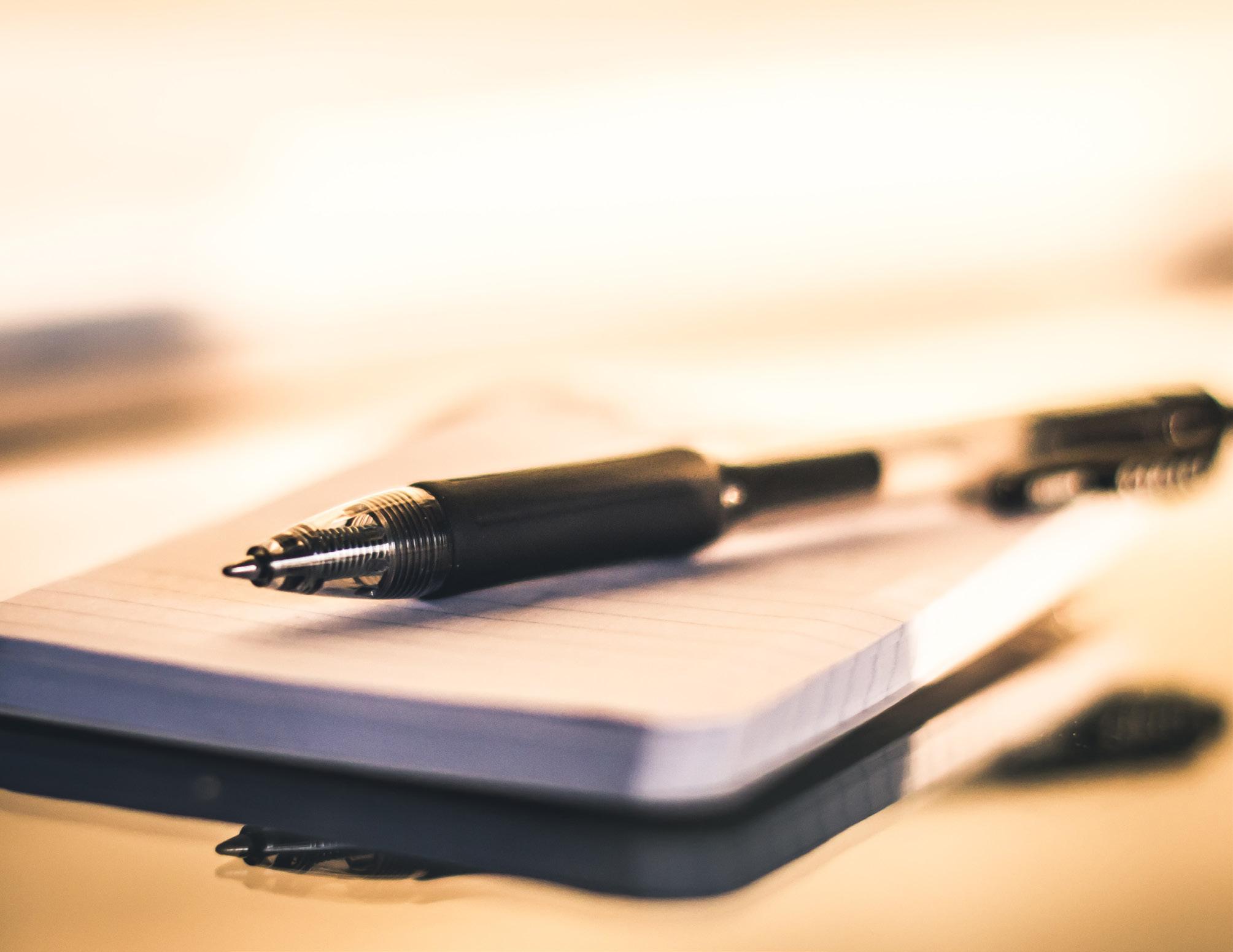
10 IN MAGAZINE JANUARY / FEBRUARY 2023 HEALTH & WELLNESS
KAREN KWAN is a freelance health, travel and lifestyle writer based in Toronto. Follow her on Twitter at @healthswellness and on Instagram at @healthandswellness.
Photo by Joe Yates on Unsplash
Be An Ally For PLHIV This New Year
When it comes to public awareness of HIV in Canada, there are significant gaps in knowledge, most notably on the impact of prescribed medications on transmission, as well as the impact of HIV on a person’s lifespan. According to HIV Perceptions in Canada, a recent nationwide Opinium Research survey commissioned by ViiV Healthcare, only two in 10 Canadians (21%) were aware that HIV cannot be sexually transmitted if the person with HIV is taking their medication as prescribed and they have suppressed the replication of HIV in their blood, and almost half of Canadians (49%) mistakenly believe that a person living with HIV will have a shorter lifespan on average, even if they are on effective treatment. These are just two examples of the limited understanding of the effects of prescribed treatment and undetectable status.
That limited understanding is unfortunate, yet not surprising. As we continue working towards destigmatizing HIV, the new year is a perfect opportunity to spread awareness of the Prevention Access Campaign’s Undetectable=Untransmittable messaging and highlight the ways in which Canadians can practise allyship with the HIV community.
To learn more about how best to reduce stigma and raise awareness of HIV within the LGBTQ+ community and the general population, we spoke to two individuals who are front and centre in this fight. Christian Hui is the co-founder of two networks for people living with HIV (PLHIV): Ontario Positive Asians (OPA+) and the Canadian Positive People Network (CPPN). Dr. Mona Loutfy is an infectious diseases specialist, clinician scientist and full professor at Women’s College Hospital and the University of Toronto.
There continues to be a misunderstanding regarding transmission for those who are taking their treatment as prescribed, and who achieve and maintain an undetectable viral load. Could you explain what Undetectable=Untransmittable (U=U) means?
Dr. Mona Loutfy: In 2011, a large trial called the HPTN 052 Study revealed that couples, where one member was living with HIV and had suppressed virus from HIV medications, had a zero chance of transmitting the virus to their sexual partner. By 2016, several additional studies, including the PARTNER Study, confirmed this finding. That is, if a person living with HIV is on HIV medications and has suppressed or has low levels of the virus, the chance of HIV transmission to a sexual partner is zero even without a condom.
In 2016, this scientific fact was coined “U=U: Undetectable equals Untransmittable.” U=U has been endorsed by many scientists and key organizations, including the CDC [US Centers for Disease Control and Prevention], UNAIDS [the Joint United Nations Programme on HIV/AIDS], WHO [the World Health Organization] and the Canadian government.
As we enter a new year, there is an opportunity for Canadians to learn more about the HIV community, the progress that has been made to improve quality of life for people living with HIV,
and ways in which people can support them. What advice do you have for people who are looking to learn more or be an ally to this community?
Christian Hui: Much education still needs to be done to ensure HIV and sexual health education is updated with the latest science and that it reaches the public. While some may think that U=U only applies to people living with HIV, the message of U=U actually affects all of us. Given that HIV does not discriminate – anyone can catch HIV – turning the tide of HIV locally and globally can be done through sustainable health-in-all policies and communityled solutions, and those are indeed a good public investment that all should care about.
Through learning about U=U as part of a combination HIV prevention strategy, you can help debunk the stigma around HIV, and become primly positioned to also learn about newer HIV prevention strategies such as pre-exposure prophylaxis (PrEP) including on-demand PrEP or long-acting injectable PrEP, and PrEP in pocket (PIP), as well as post-exposure prophylaxis (PEP), which are all part of the HIV prevention toolkit.
If we are truly serious about ending HIV/AIDS, we must all do our part to educate ourselves, challenge our own biases and assumptions, and keep HIV/AIDS on the agenda.
In your professional opinion, what measures do we need to take to address the knowledge gap in Canada?
ML: I think we need a countrywide education program, with an information sheet about HIV sent out to every single household about the advances and truth about HIV being a manageable disease. In doing so, we can decrease the stigma and discrimination associated with it. We only have one day where the public hears about HIV –World AIDS Day on December 1 – but every day [should be] World AIDS Day, as 38 million people in the world are living with HIV and over 65,000 of them live in Canada.
If you could have just one goal for this upcoming year in relation to your work, what would it be?
CH: To continue onwards with my work as an HIV activist and U=U advocate for historically oppressed communities, including BIPOC [Black, Indigenous and People of Colour], women, twospirit and trans/nonbinary and gender-diverse people, and key priority population groups, just to name a few. While engaging in this work can at times be challenging, I know that within challenges comes opportunities.
To learn more about the Prevention Access Undetectable=Untransmittable campaign, please visit preventionaccess.org. To learn more about the HIV Perceptions in Canada survey results, and its global findings, please visit viivhealthcare.com/hiv-news-andmedia/medical-conferences-and-events/world-aids-day.
11 COMMUNITY
We talk to activist Christian Hui and Dr. Mona Loutfy about how Canadians can be allies and support the community of those living with HIV
LEARN THE FOREIGN LANGUAGE OF ELECTRIC VEHICLES
Electric vehicles (EV) run on electricity alone. Here’s everything else that you need to know
 By Casey Williams
By Casey Williams
As somebody who loves to travel, it is always challenging to speak the local language. Even ordering a soda has tested my knowledge of French, Spanish and Italian – occasionally at the same time. It’s much the same for those of us whose native automotive language is gasoline when electricity is becoming the dominant dialect. Fortunately, I speak EV better than French.
EV 101
A Battery Electric Vehicle (BEV) is a car that runs exclusively on batteries – no extra gas engine as in hybrids. These are cars like the Chevy Bolt, Kia EV6, and all Teslas. They employ Regenerative Braking (Regen), which replenishes electricity to the batteries when decelerating instead of releasing the kinetic energy as heat. Range is how far you can travel from fully charged to calling your boyfriend for a lift – typically a minimum of 400 kilometres, but extending to 645 kilometres for a Lucid Air.
You may have read about “one-pedal driving” and become completely discombobulated. Many EVs allow drivers to adjust the aggressiveness of this feature, but it automatically engages regen when the accelerator is released, allowing most driving without a brake pedal. Lift off the accelerator and the vehicle decelerates – easy as that.
Other terms are more familiar. Horsepower still defines work being done – a measure from the gasoline era that defines automotive performance. Torque is the twisting force that turns a vehicle’s wheels, typically higher in EVs. Unlike gas-powered vehicles, in which the engine has to rev up to produce peak power, electric motors produce power instantaneously, enabling the swift smooth acceleration that is a hallmark of EVs.
EV 201
Now, we move into advanced language. Energy potential is expressed as kilowatt-hours (kWh), or the current a battery can emit over an hour. Higher kWh means more range, acceleration or towing capacity. Batteries are bigger in trucks than in sports cars: good because bigger batteries equal more kWh. When I first drove the GM EV1 in 1996, it ran on lead-acid batteries that had been around since the Model T days. Today’s EVs employ lithium-ion batteries. That’s a high-density battery composition that was popularized in smartphones and laptop computers before migrating to EVs.
There are a few more terms you may want to learn. Three levels of chargers allow increasing speeds of charging. A Level 1 charger is essentially an EV plugged into a wall outlet. It takes days to fully recharge. Moving up to a Level 2 charger – typical for home and commercial installation – brings that time down to under 10 hours. The fastest Level 3 DC Fast Chargers can replenish a battery pack in about 30 minutes – a little more for a pickup truck like the Ford F-150 Lightning.
We’ll finish this lesson with two more words: drag coefficient. That’s not your ability to woo RuPaul, but rather a measure of a vehicle’s resistance to the wind that contributes to range, acceleration and wind noise. Take this little lesson to heart and you’ll dominate the runway, roadway and driveway in the next era of driving.
12 IN MAGAZINE JANUARY / FEBRUARY 2023 WHEELS
Photo by CHUTTERSNAP on Unsplash
CASEY WILLIAMS is a contributing writer for Gaywheels.com. He contributes to the New York-based LGBT magazine Metrosource and the Chicago Tribune. He and his husband live in Indianapolis, where Williams contributes videos and reviews to wfyi.org, the area’s PBS/NPR station.
TAKING COLLECTIVE ACTION TO COMBAT HATE CRIMES TAKING COLLECTIVE ACTION TO COMBAT HATE CRIMES
Canada’s largest 2SLGBTQI+ network is leading communities in the drive to do what we have always done – take care of one another
Canada’s largest 2SLGBTQI+ network is leading communities in the drive to do what we have always done – take care of one another
The recent massacre at a drag show in Colorado Springs has not only moved the LGBTQ+ community into a period of mourning, but also one of reckoning with the recent sharp spike in hate crimes against two-spirit, lesbian, gay, bisexual, transgender, queer and intersex (2SLGBTQI+) communities in Canada.
Statistics Canada’s findings on police-reported crimes for 2021 show that the rise of hate crimes on the basis of sexual orientation has increased by 60 per cent in recent years.
Last summer, the community woke up to alarms that one of our youth 2SLGBTQI+ member organizations was under attack. The deep dark discriminatory corners of the internet were converging on OutLoud North Bay, an Enchanté Network member organization and one of the only safe havens for 2SLGBTQI+ youth in Northern Ontario. The flyer promoting their for-youth-by-youth drag show was shared on a homophobic and transphobic Twitter account with about 1.5 million followers. Almost immediately, the local LGBT centre was inundated with hateful messages ranging from slurs to death threats.
The Enchanté Network is Canada’s largest network of 2SLGBTQI+ organizations, with more than 200 member organizations spanning every province and territory. This year alone, we have had to field dozens of reports from our members about hate-motivated incidents in their regions of the country.

Like OutLoud North Bay, our member organizations in Saskatoon, Vancouver, Montreal, St. John’s and countless other cities know first-hand the disruption and devastation that targeted hate attacks, whether online or in person, can have on a 2SLGBTQI+ organization’s staff, volunteers and community.
Our collective work is committed to building an equitable world where hate has no place – and so, addressing hate is a major policy priority for the Enchanté Network.
By Tyler Boyce
By Tyler Boyce
Taking care of one another
In the wake of the attacks on OutLoud North Bay, we saw 2SLGBTQI+ communities and allies do what we have always done – take care of one another.
Our network is collective power and, together, we act as a net to catch each other when we fall.
Through the hashtag #IStandWithOutLoud, the Enchanté Network generated and collected messages of solidarity from across the country; countless members and allies shared links to donate to OutLoud North Bay; and, like a united drumbeat across the country, 2SLGBTQI+ communities declared to the world that our abundance will leave no room for hate in Canada.
When our communities are uplifted with the resources, advocacy and support we need to thrive and continue sustaining our missions, we are able to build strong responses that will tackle hate.
We are calling on Canadians to get into the business of movement building. To donate to their local 2SLGBTQI+ organization. To pour into a society that we can be proud of. To support every person’s right to be themself.
We ground ourselves in hope through our work in advocacy and community building, through the front-line services and resources for queer and trans communities that is provided by organizations across the country, and through responses such as the federal government’s 2SLGBTQI+ Action Plan that commit resources to building a more inclusive and safe world for everyone.
It is going to take all of us – but when I reflect on the long road that 2SLGBQTI+ communities and our allies have already walked to get us to where we are today, I only feel hope.
Photo by Alexander Grey on Unsplash
13 ADVOCACY
TYLER BOYCE is a nationally recognized human rights activist and the executive director of the Enchanté Network, Canada’s largest network of 2SLGBTQI+ organizations. He is also an adjunct professor in the University of Ottawa’s Faculty of Law, where he teaches Deconstruction of Racism in the Law. In 2022, he was recognized as one of Future of Good’s 30 Young Impact Leaders To Watch. His leadership is grounded in Black Queer Feminist Thought, Queer Theory and a commitment to bridging the worlds of research, public policy and social justice.
WHEN I
GROW UP, I WANT TO BE A LIGHTWORKER
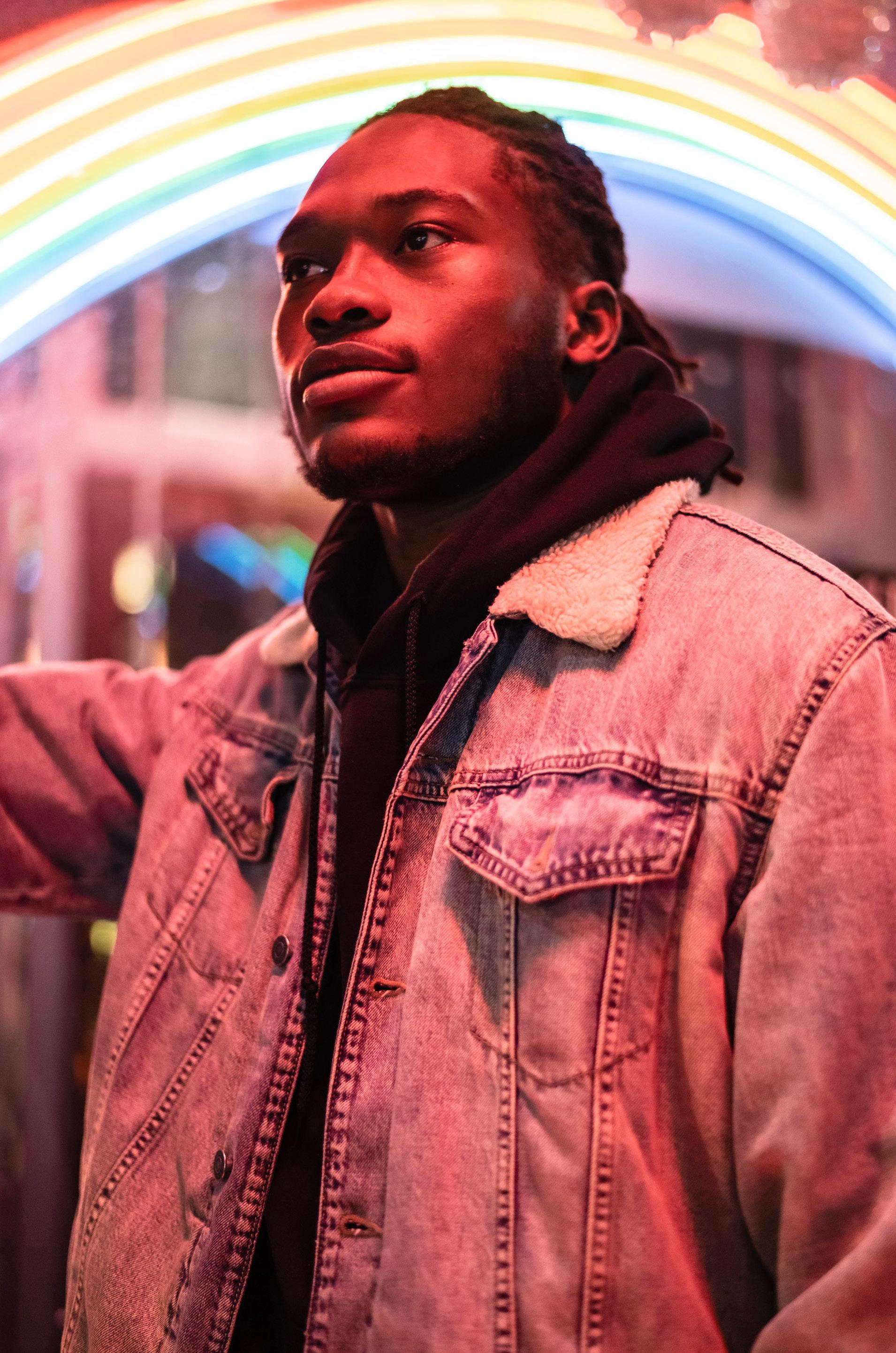
When we shine our own light, we empower others to light up, too
By Jumol Royes
14 IN MAGAZINE JANUARY / FEBRUARY 2023 PERSPECTIVE
Photo by PNW Production from Pexels
Every time I listen to the song “This Little Light of Mine,” I can’t help but feel inspired.
I remember singing it during elementary school assemblies and feeling a sense of awe and wonder while picturing a bright light inside of me just bursting to get out. Being a lightworker wasn’t one of the options presented to me in terms of a career, but I’m pretty sure that’s what I wanted to be when I grew up.
The song would later help me navigate my way through dark seasons of depression and anxiety as an adult, like a lighthouse guiding me to safe harbour. It’s one of those tunes that has always stayed with me and still stirs something deep within my soul.
“This Little Light of Mine” is known to countless people around the world as a cherished children’s song. It’s also a spiritual that became popular in Black churches south of the border before being embraced by the US civil rights movement in the 1950s and ’60s, becoming better known as a “freedom song.”
Back then, it was sung by student activists at protests as police officers threatened to beat them with billy clubs. It was also used by counter-protesters in Charlottesville, Virginia, as recently as 2017 to drown out the anti-Semitic remarks and homophobic slurs being hurled at them by hate-filled white supremacists.
Whether it’s being sung joyfully and jubilantly by innocent schoolchildren, or by activists in defiance of systemic injustice and oppression, the song is a response to all the darkness in the world, and a call to action declaring that a little light can shine so brightly it’ll blind you.
Put simply, it’s the anthem of the lightworkers. But what does it mean to be a lightworker?
A lightworker is someone who feels called to transmute darkness into light and who devotes their life to being a bright light in the world. They’re typically philosophical; spiritual, rather than religious; and highly intuitive, with an almost psychic ability to pick up on what other people are thinking or feeling.
They tend to be ‘old souls’ who are extremely sensitive to other people’s emotions, possess an aptitude for self-awareness, are committed to personal and collective transformation and have a deep desire to help others.
Another good predictor for being a lightworker is someone who has overcome obstacles and encountered traumatic events early on in life, and then has used those experiences as opportunities for deeper awareness and healing.
As the celebrated Sufi poet Rumi once said, “The wound is the place where the light enters you.”
We all know of or have heard stories about people like this. Former professional hockey player Brock McGillis comes to mind. He spent years living in denial because he was gay and is now an outspoken advocate for the LGBTQ2+ community, travelling across Canada speaking to schools, sports teams and organizations about inclusivity.
Lightworkers transform their pain into their purpose.
I wrote an article when I was 10 years old that was published in the country’s largest daily newspaper. I cut it out and wrote on the back, “When I grow up, I want to be a journalist,” before filing it away in a drawer and forgetting about it.
Then fate intervened, and I happened to catch an interview recently with Nobel Peace Prize winner and Filipino journalist Maria Ressa, who is risking life in prison while fighting for press freedom. In it, she said, “[As] journalists, we shine the light.”
And it all clicked for me.
I may not have had the language when I was young to articulate that I felt called to be a lightworker, but I must have intuitively known that journalists are lightworkers, shining a light on truth.
I eventually found my way back to journalism and now write about themes like compassion, community, identity and belonging. Through my storytelling, I endeavour to shine a light on the stories and lived experiences of equity-deserving communities – specifically Black and LGBTQ2+ folks – so that we feel seen, heard and understood, and know that we matter.
The beautiful thing about illuminating our own light is that it empowers others to light up, too.
This little light of mine. Let it shine, let it shine, let it shine.
15 PERSPECTIVE
JUMOL ROYES is IN Magazine’s director of communications and community engagement, a GTA-based storyteller and glass-half-full kinda guy. He writes about compassion, community, identity and belonging. His guilty pleasure is watching the Real Housewives. Follow him on Twitter at @Jumol and on Instagram at @jumolroyes.
“ A LIGHTWORKER IS SOMEONE WHO FEELS CALLED TO TRANSMUTE DARKNESS INTO LIGHT AND WHO DEVOTES THEIR LIFE TO BEING A BRIGHT LIGHT IN THE WORLD.”
ROBERT WATSON IS ALL ABOUT QUEER JOY
We talked to the Toronto comedian about hosting Gay AF, his new comedy album and what’s next for him
We talked to the Toronto comedian about hosting Gay AF, his new comedy and what’s next him
By Courtney Hardwick
By Courtney Hardwick
Robert Watson is a playwright and the creator of A Gay Victorian Affair, an award-winning web series that tells the story of a gay man and lesbian woman in Victorian England who enter into a marriage of convenience in order to keep their true desires a secret. With over three million views on YouTube and four Canadian Comedy Awards, the web series is one of Watson’s proudest achievements. But he’s not stopping there.
He wants to help other LGBTQ+ voices break through in the comedy world, too.That’s what Gay AF is all about. Started in April 2019 as a monthly show, it has evolved into a full stand-up comedy brand featuring top-notch queer comedians who represent the many intersections of the LGBTQ2S+ community. We sat down with Watson to find out what’s next for Gay AF and how he is making space for queer voices in comedy – including himself.
How did you get into stand-up comedy?
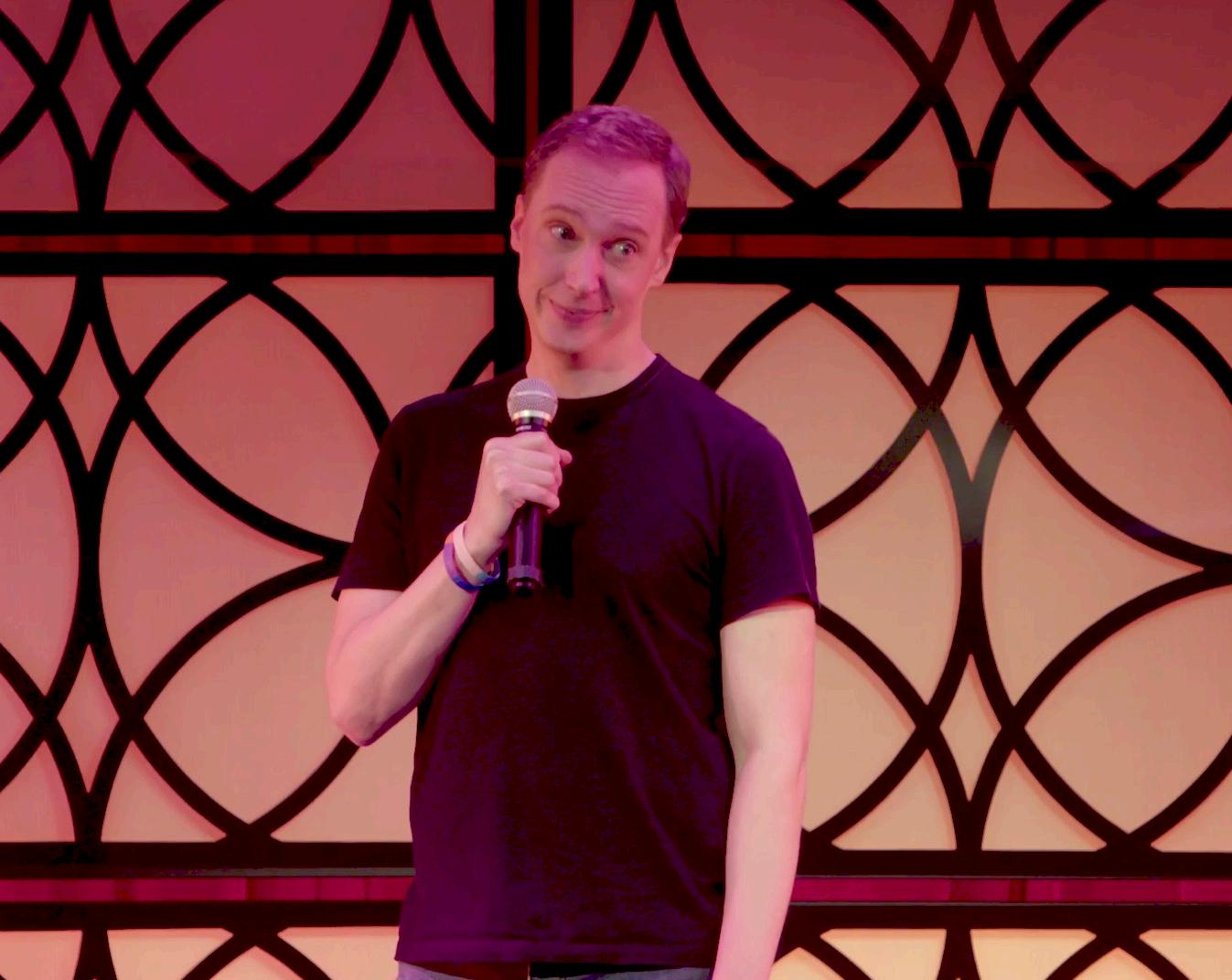
I’ve got a theatre background, so my interests always sort of led me to comedy. I think a lot of gay men are like, oh yeah, I’m a natural comedian. You know, we all think we’re funny. I was one of those gay guys; I think I’m pretty funny. So I was like, okay, I’ll do some stand-up.
I started out a lot later than I think most people start doing stand-up simply because I didn’t think there was space for me in the comedy community. I remember one of the first queer comedians I saw was Eddie Izzard. She got on stage and, using the language available at the time, just described who she was and she said, ‘This is me and this is my comedy.’ I never thought that would be possible for me, but seeing that she could fill a theatre full of people, I was like, oh, I can do this too.
It’s changed over the last two years and particularly over the last five or six, where there seems to be a lot more place for queer comedians. People want to hear our voices, and our community
is realizing that there are some good comedians who identify as queer that we can go see and enjoy.
What made you want to start the Gay AF brand?
My friend and I started Gay AF together and he decided he was going to concentrate on some other comedy endeavours, so I was left this lovely gift of a queer comedy show where I could provide a stage for a whole bunch of comedians who aren’t necessarily getting a lot of stage time in the regular comedy world. And as the host, I ended up giving myself a stage as well.
I also feel like our typical audience is coming to have a laugh, but they also want to know they won’t have to hear jokes that disparage their community, and that’s something a show like Gay AF can provide. When you have popular comedians like Dave Chappelle saying the things that he does, it becomes more important than ever to provide a stage for people who aren’t on board with the convention that it’s still okay to pick on a marginalized community.
16 IN MAGAZINE JANUARY / FEBRUARY 2023
Photos by Andrew Lamb
COMEDY
There are still so many people who don’t want us to exist, and that gives producing Gay AF an extra layer that goes beyond comedy. It’s about visibility and creating community. The longer I do it, the more it has expanded into being affirmation for any queer person who is watching. At least, that’s my hope.
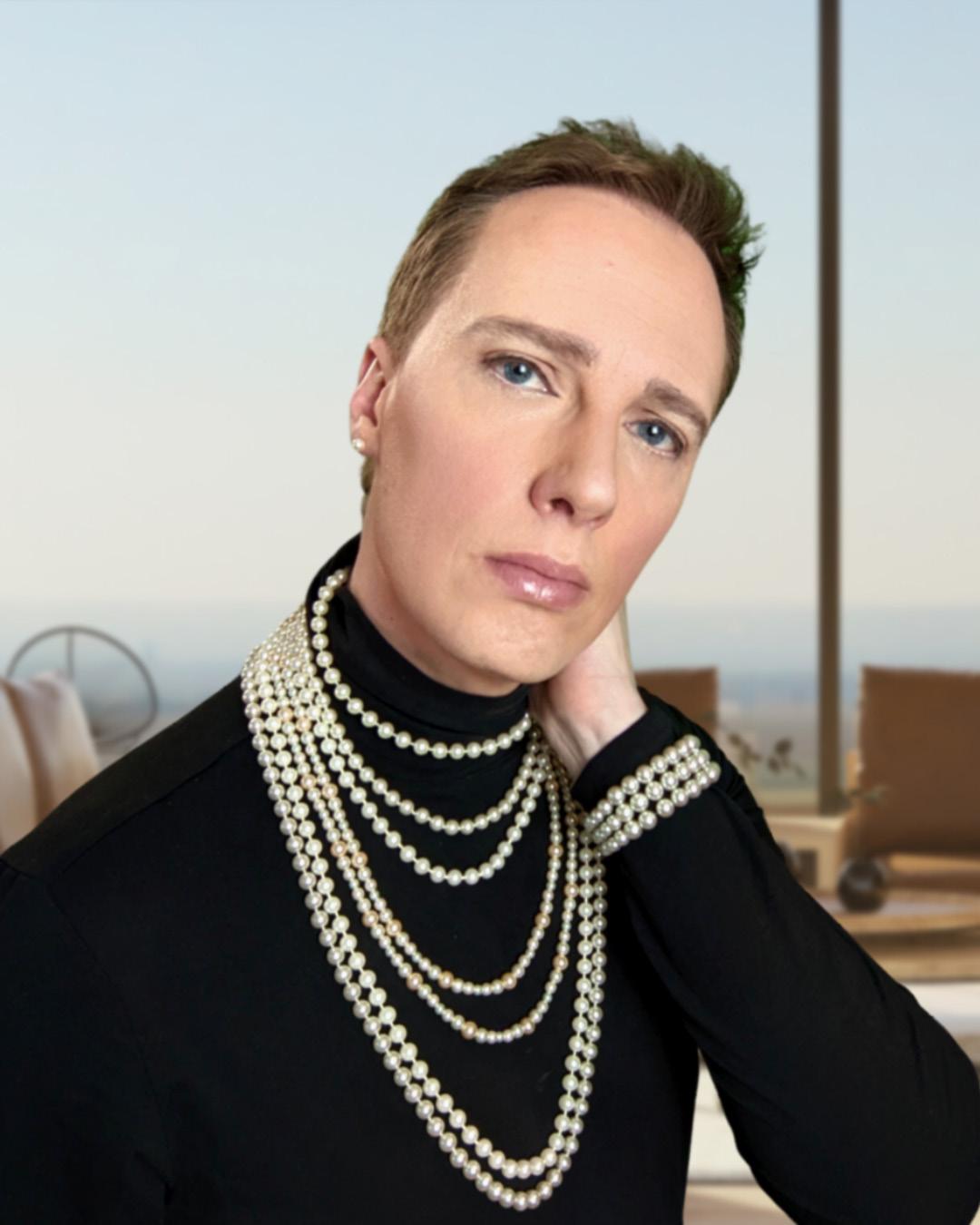
How would you describe your own personal approach to stand-up comedy?
I make my comedy for queer people, and everyone’s invited. I’ve also described it as ‘super gay’ in the sense that there are no apologies for the content. I’ve been really latching onto the idea of queer joy, which is two things: the joy felt from seeing progress being made towards equality and the joy felt from feeling comfortable enough to live as your authentic self. I think what I want to exude in my comedy, whether I’m hosting or doing my own set, is the idea of feeling joy about being unapologetically myself. Because it’s been a journey, and that is what it is for so many queer folks: a journey to self-acceptance and loving yourself. My first album, Homo Say What? is coming out in January 2023, and I describe it as ‘30 minutes of queer joy with a side of tea’ because I try my best to serve a little bit of truth and challenge some of the stereotypes in the gay community in a funny way.
Part of releasing this album is a chance for me to turn a little bit of focus onto myself and let people get to know me as a comedian beyond my role as host of the Gay AF show. The lovely thing about the album was that I was able to take all of my material and deliver it just as me, without worrying about everything that goes into hosting like making sure the crowd is warmed up for all the other comedians.
What’s next for you and Gay AF?
For me as a host, I’ve learned so much about community, and I want to keep building on that. It’s a balancing act, making sure the audience feels good, the comedians feel good, and everyone walks away feeling like they had a positive experience.
I’ve been asked to bring the show to a rural community or a place that isn’t as populated with queer people but has an audience that has expressed interest in seeing queer comedians. I also would like to work towards making queer comedy a bigger part of Pride celebrations, hopefully across the province.
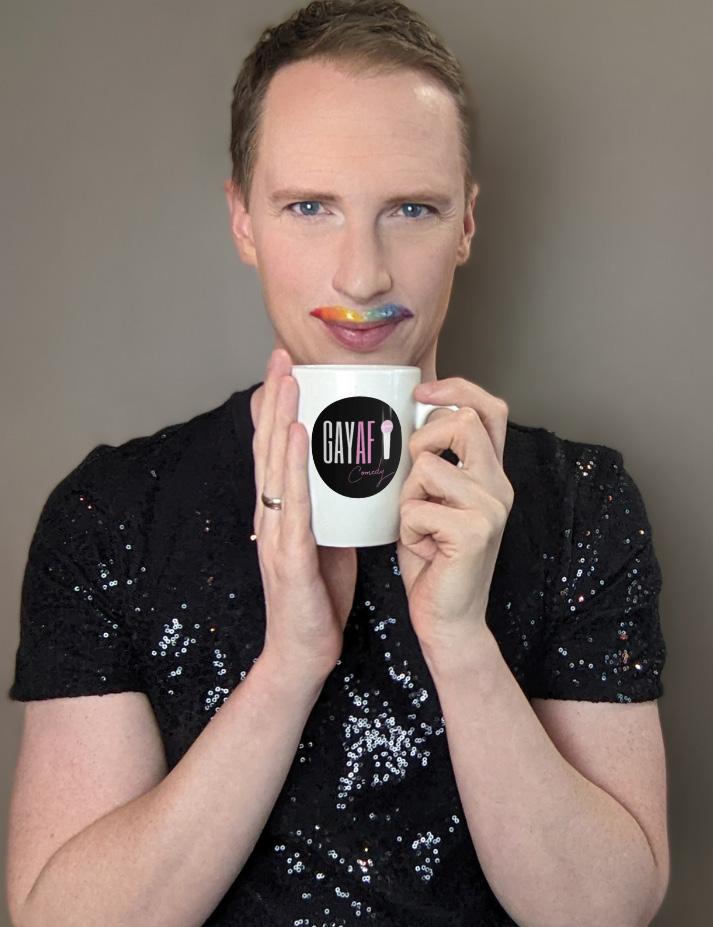
As a white, gay man in Toronto, I’m aware that I have some privilege and I want to keep helping extend the opportunity for visibility to the rest of the LGBTQ+ community. I think sometimes we need to remember that the fight isn’t over yet and that we have a whole community that lifted us up and we have to lift them up as well. So let’s fight the fight with jokes.
Robert Watson’s debut comedy special Out For Laughs, recorded in 2021, can be found on Amazon Prime and OutTV. His debut comedy album Homo Say What? will be released in late January 2023. You can follow him on Instagram at @gayafcomedy and on Twitter at @ThisIsRobWatson.
17 COMEDY COURTNEY HARDWICK is a Toronto-based freelance writer. Her work has appeared online at AmongMen, Complex Canada, Elle Canada and TheBolde.
Do Gay People Actually Know How To Talk?
AN INVESTIGATION
While slang and lingo serve as a cornerstone for creating a sense of community among queer individuals, it grows increasingly questionable as to who truly understands this language and who is simply regurgitating what they see online
By Jesse Boland
“That’s great you finally found your voice as a queer person, but why does it have a blaccent?”

I had one of the most baffling conversations with an acquaintance the other weekend. It was about the withstanding impact of slavery in modern-day America, and the standalone highlight for me was, “Honestly, Harriet Tubman was so mother for what she did.” That comment left me simply wondering, how did we as gay people get here in terms of the language we consciously choose, with zero irony, to chronicle the experience of our lives?
As our political climate drifts ever closer to the point where elected officials tweet in earnest, “Sashay away, periodt” in the context of deporting Haitian refugees, a girl can’t help but wonder how the
colloquial language of Black and Latino trans women, sex workers and drag queens from the rough streets of the Bronx found its way into the boardrooms and legislatures. While slang and colloquial jargon belonging to marginalized groups are usually intended to be used with a degree of insouciance, just how many people falling under the spectrum of queer identity have the jurisdiction to freely throw about these terms? And, stemming from that, how many of us have embraced the act of verbal minstrelsy in the name of queer self-expression?
A hard pill to swallow is the understanding that shared identity does not inherently create community. While there is a sense of unspoken human connection between all queer people, it is naive to believe that the lived experience of a Black trans woman living
18 IN MAGAZINE JANUARY / FEBRUARY 2023 TALK
Photo by Thiago Barletta on Unsplash
in Harlem is comparable to that of a cis white male in Vancouver based solely on the commonality of not fully meeting the criteria of heteronormativity.
So why does the latter so commonly speak with the same lingo and vocal stylings of the former? For one, many queer people simply do not know how to be queer at first, or at least what they believe the imagined idea of queerness is expected to be from them. Unlike other facets of identity that derive from specific branches of culture such as religion, ethnicity, nationality and other cultural facets, queer identity is not taught from a young age within the home but rather learned later in life, typically leading up to adulthood. What that often results in is teenagers and young adults being left to navigate this journey towards self-identity on their own. And what do people do when they’re feeling lost and on their own for the first time? Why, they refer to the internet, of course!
to is the underground ballroom scenes of New York and Chicago, a subculture created by the socially ostracized Black and Latino queers and femmes whose robust histories cannot be comprehended by white mainstream America – despite the efforts of Ryan Murphy and RuPaul to commercialize and bottle it into a product before being sold alongside McDouble sandwiches. With the growing expansions of the Drag Race extended universe as well as the short-lived but nonetheless beloved Pose and Legendary , the underground has been extracted from the earth and thrust into the harsh light of the carnivorous mainstream to be feasted upon, and not just by straight people.
We can clown on Shawn Mendes’ discombobulated use of “it’s giving…it’s giving Cher,” or roll our eyes at our straight coworkers exclaiming, “Slay!” to thank us for updating the Team Google doc, but are we really going to pretend that white twinks using the phrase “serving cunt” to describe their white Vans x Zara button-up x skinny chain outfit combo is any less cringe?
Ballroom icon and former Legendary judge Leiomy Maldonado has vocally expressed her disdain for popular vogue moves such as a dip being publicly mislabelled as a “death drop” by the poorly informed general public. This misappropriation of queer terms by other queer people is not unusual, and can be seen as prominently as Sam Smith proudly proclaiming themself as “trade” simply for wearing a plaid shirt and not smiling in photos, despite being openly queer and not Black and therefore not being trade by literally any sense of the term’s definition.
When we fail to acknowledge the historical context of a term’s origin – for example, Doll(s) is used to refer to trans women due to its reference to the steroid hormone estradiol, and thus should not be used by cis gay men to affectionately refer to their rugby team – we are undermining the integrity of its creators and are willingly participating in the dilution of their culture, much in the same way that we bemoan what straight people do to us.
Many queer people from small towns or more conservativeleaning homes have said that connecting with fellow queer people online was their first time genuinely feeling embraced with their community despite the physical limitations of geographical barriers. For this, social media can be a wonderful tool for community and interconnectivity – but the issue is that too often the extension of queerness becomes distorted in these spaces. The internet allows access to knowledge and information that, frankly, we have no business knowing, and above all it allows individuals to join conversations we were not invited to. From viral shit-posting tweets popping up on our timelines to decontextualized Real Housewives of Atlanta clips making their way into our group chats as cheekily humorous memes, it can become easy for queer AAVE – that’s African American Vernacular English btw – to feel as though it is a part of our daily lives, with the act of interacting with actual queer Black people not needed.
For many non-Black queer people, this exposure to Black gay culture via the means of online engagement has created a sense of overfamiliarity and entitlement into realms of lived experience far beyond their own compression. In truth, when we speak of what is believed to be “gay culture,” what we are often referring
Perhaps the most culturally significant statement ever uttered in the history of modern linguistic studies was the objecting assertion, “Yo Buckwild, where’d your accent go?” by rapper Flavor Flav addressing his potential paramour Becky “Buckwild” Johnston dropping her verbally minstrel performance of southern Black American identity upon deciding to be serious. What that brief clip from the golden days of late 2000s reality television provided us was an encapsulation of exactly how depictions of racialized idealizations of self can instantly be performed and then dropped at the ready by its appropriators as though it were a costume change.
This is not to say that the casual dropping of “she’s in her flop era” equates to that of Laganja Estranja adjacent butchering of AAVE, but we would all benefit to sometimes question our proximity to the root source of the jargon we are recycling in our day-to-day dialogues. As we as queer people continue to navigate our journey to authentic self-expression through personal growth, we would be wise to attempt to differentiate words of dialogues by our community members and confidants versus the invasive thoughts accumulating in our minds from chronic engagement to K-pop display pictured Twitter accounts.
All this to ask…was Harriet Tubman really giving mutha?
19 TALK
“A HARD PILL TO SWALLOW IS THE UNDERSTANDING THAT SHARED IDENTITY DOES NOT INHERENTLY CREATE COMMUNITY.”
JESSE BOLAND is that gay kid in class who your English teacher always believed in. He’s a graduate of English at Ryerson University (now Toronto Metropolitan University) who has a passion for giving a voice to people who don’t have data on their phones and who chases his dreams by foot because he never got his driver’s licence.
New Queer Movies Coming Out In 2023 That We Can’t Wait To See 8
Here are some of the films that you just have to see this year
 By Matthew Creith
By Matthew Creith
After a fantastic year where queer representation was perhaps at an all-time high in films released to theatres and streaming platforms, 2023 looks to be another year full of interesting stories involving the LGBTQ2+ community. Here is a list of eight queer movies coming out in 2023 that we can’t wait to see.
Rustin
Directed by George C. Wolfe (Ma Rainey’s Black Bottom) and co-written by Dustin Lance Black (Milk), Rustin explores the life of gay civil rights activist Bayard Rustin, who worked with civil rights leaders of the era to organize the March on Washington in 1963. He also helped the Southern Christian Leadership Conference to advise Martin Luther King Jr. Because of his sexuality and the criticism thrown at civil rights leaders of the day, much of Rustin’s work was done behind the scenes. Produced by Barack and Michelle Obama’s Higher Ground Productions, Rustin stars Emmy Award winner Colman Domingo as Bayard Rustin, joined by Chris Rock, Audra McDonald, Glynn Turman, Bill Irwin, and British actor Aml Ameen as Martin Luther King Jr.
Rustin will be available to stream on Netflix sometime in 2023.
Maestro
Bradley Cooper co-writes, directs and stars in Maestro, one of the more controversial films coming out in 2023. Produced by Steven Spielberg and Martin Scorsese, this biographical film about legendary composer Leonard Bernstein will dive into Bernstein’s turbulent marriage to actor Felicia Montealegre (Carey Mulligan), while not shying away from his secret life as a queer man. Depicting the double life of a man who eventually became one of the world’s foremost conductors and composers, Bradley Cooper has already received backlash in first-look pictures for how his Jewish character will appear in the film. However, the movie is aided by a strong ensemble cast that includes Jeremy Strong, Matt Bomer, Maya Hawke and comedian Sarah Silverman.
Maestro will be available to stream on Netflix sometime in 2023.
Good Grief
Canadian multi-hyphenate Dan Levy might be most famous for Schitt’s Creek, but his work in films appears to be just getting started. Levy will write, direct and co-star in Good Grief, a romantic dramedy about death and unexpected self-discovery. While Marc (Levy) is mourning the loss of his mother, his husband also dies out of the blue, sending his world upside down. To face the grief head-on, Marc decides to travel to Paris for a weekend getaway with two of his friends, who try to help him figure out where he goes from here.
Good Grief will be available to stream on Netflix sometime in 2023.
Down Low
Directed by Rightor Doyle ( Bonding), the comedy Down Low chronicles the heavy circumstances of a sexually repressed man (Zachary Quinto) who receives a happy ending from a more uninhibited younger guy (Lukas Gage). The two form a bond that ultimately ruins the lives of those around them. Down Low is written by Phoebe Fisher (TV’s I Know What You Did Last Summer) and Lukas Gage (The White Lotus), with a cast that includes queer icon Judith Light as well as Audra McDonald, Simon Rex and newcomer Sebastian Arroyo.
Down Low will be released sometime in 2023.
20 IN MAGAZINE JANUARY / FEBRUARY 2023 FILM
Teen Wolf: The Movie
The television series Teen Wolf aired for six seasons from 2011 to 2017, opening the doors for other supernatural teen dramas. The television adaptation, which was based on the 1985 film starring Michael J. Fox, was noteworthy for flirting with homoerotic themes spliced together with violence and gore. To continue the show’s storylines, Paramount+ will stream Teen Wolf: The Movie, written by Jeff Davis and directed by Russell Mulcahy, both of whom identify as gay men. Since the television series first premiered, some of its original cast members have come out as queer, and the upcoming film version will see the return of some of them, like stars Tyler Posey and Colton Haynes. Other cast members in the movie version will be Crystal Reed, Tyler Hoechlin, JR Bourne, Shelley Hennig and Holland Roden.
Teen Wolf: The Movie will be available to stream on Paramount+ on January 26, 2023.
Of an Age
Having premiered at the Melbourne International Film Festival in 2022, the Australian movie Of an Age will finally see its American and Canadian debut in 2023. Presented by Focus Features, the movie concerns a Serbian ballroom dancer named Kol (Elias Anton) who thrusts himself into a passionate 24-hour romantic entanglement with Adam (Thom Green), who happens to be the brother of Kol’s dance partner (Hattie Hook). Of an Age took top honours at CinefestOZ, where it won the Best Film Award, and is directed by queer filmmaker Goran Stolevski (You Won’t Be Alone).
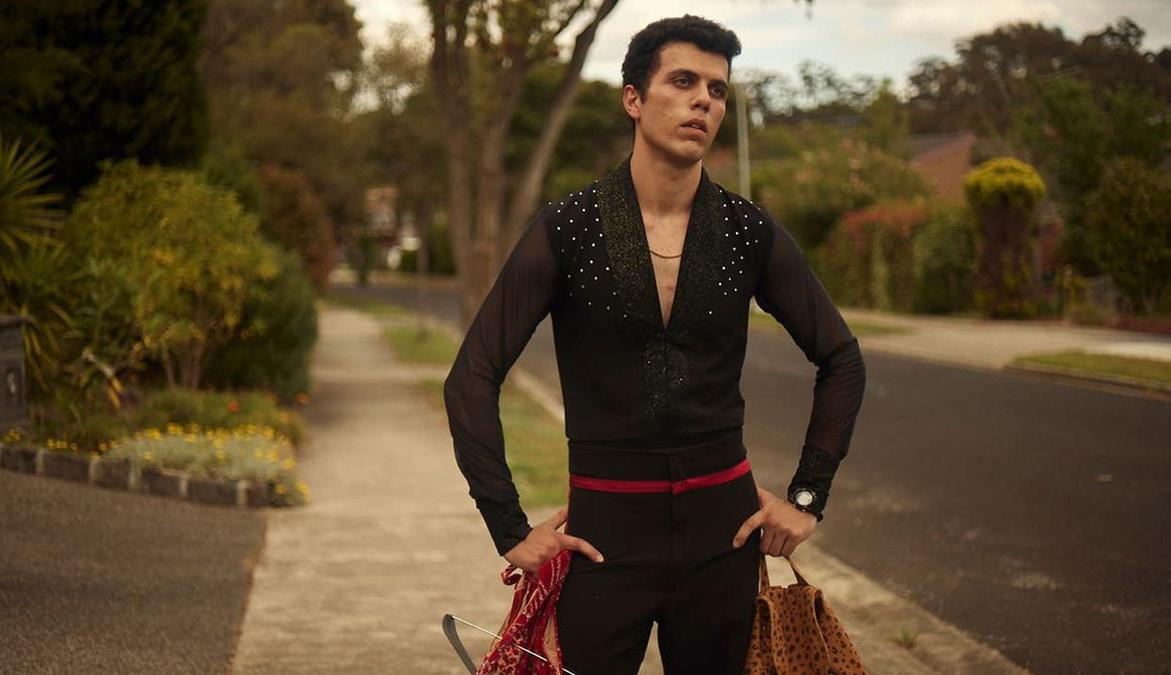
Of an Age will be released in limited theatres on February 10, 2023.
Knock at the Cabin
Good or bad, any time a new M. Night Shyamalan movie drops, it tends to be quite the event. This time, the horror director will take audiences on an apocalyptic psychological journey about the end of days. While Andrew (Jonathan Groff) and Eric (Ben Aldridge) are vacationing with their daughter (newcomer Kristen Cui) in a remote cabin, they are taken hostage by a group of doomsdayers led by Leonard (Dave Bautista). The family of three must make a sacrifice to stave off the impending apocalypse. As with much of Shyamalan’s work, there is bound to be a twist ending to this frightening tale.
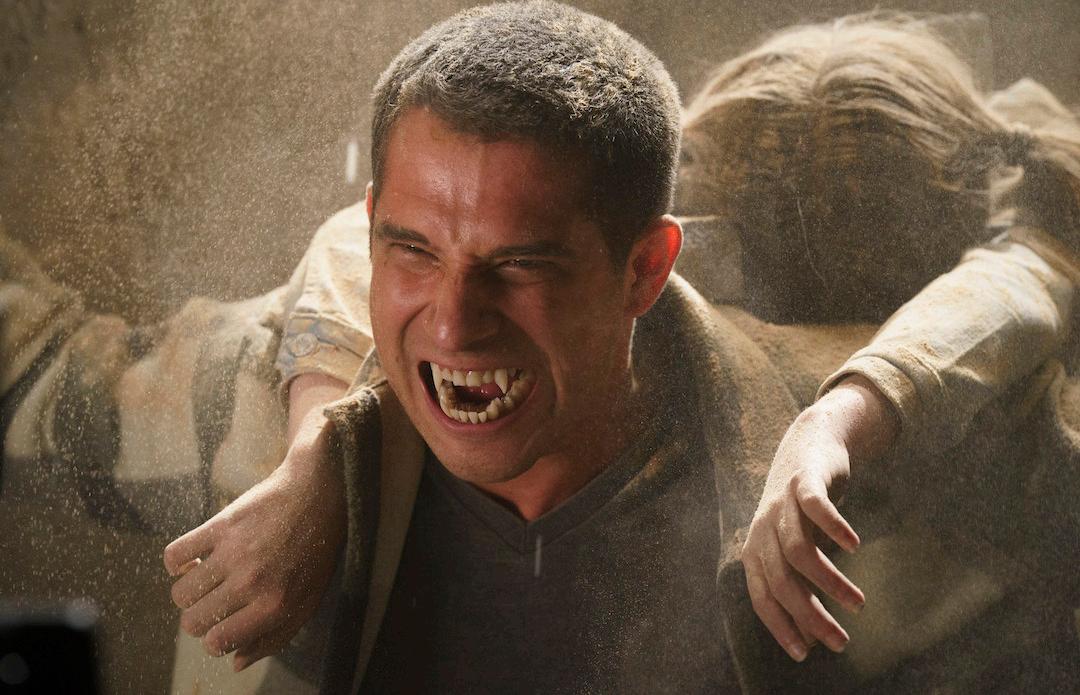
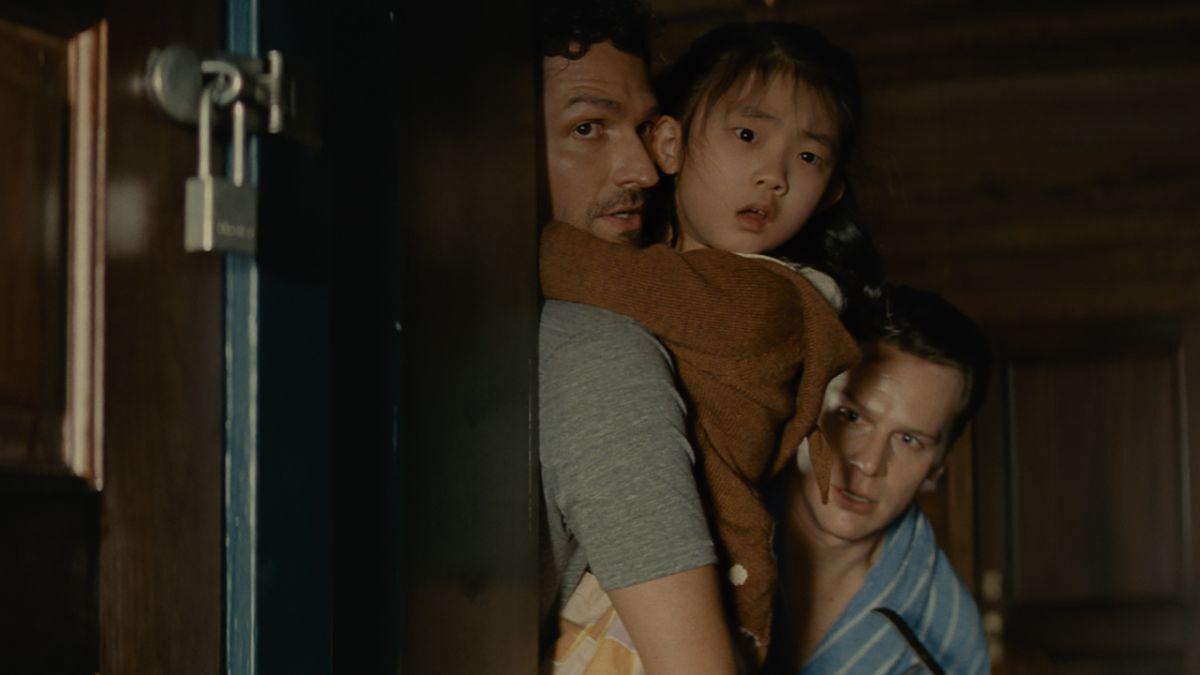
Knock at the Cabin will be released in theatres on February 3, 2023.
Barbie
While not the most obviously queer film to make this list, the likely campiness of this neon-decked-out movie will no doubt be a winner among the LGBTQ2+ crowd. Barbie stars Margot Robbie as the titular Mattel doll opposite Ryan Gosling as Ken in the franchise’s first live-action film. While the plot has been a secret for quite some time, Barbie is directed by Greta Gerwig (Lady Bird, Little Women), and co-written by Gerwig and Marriage Story helmer Noah Baumbach. Co-starring queer actors Scott Evans, Kate McKinnon and Alexandra Shipp as well as trans model Hari Nef, Barbie will feature a huge cast that includes America Ferrera, Simu Liu, Kingsley Ben-Adir, Issa Rae, Michael Cera, Will Ferrell, Emerald Fennell and Ncuti Gatwa.
Barbie will be released in theatres on July 21, 2023.

21
Entertainment Critics,
may also know him
his work on Matinee
Screen Rant and Giant Freakin
You can find him on Twitter at @matthew_creith or Instagram at matineewithmatt. FILM
MATTHEW CREITH is a freelance journalist based in Austin, Texas. He is a member of GALECA: The Society of LGBTQ
and participates in the association’s Dorian Awards. You
for
With Matt,
Robot.
I Love the Way Your Foul Little Mind Works:
THE QUEER ICONOGRAPHY OF CINEMATIC VILLAINS
How the LGBTQ+ community has reclaimed queer-coded villains
By Rowan O’Brien

22 IN MAGAZINE JANUARY / FEBRUARY 2023 FILM
Photo by Gabriel Meinert on Unsplash
Though horror originally used queerness as another way to shock the audience, the genre has now been reclaimed by a growing queer fanbase. From Halloween being colloquially known as “gay Christmas,” to television series like The Boulet Brothers’ Dragula (2016–present), the genre of horror has become a queer icon in its own right. Queer horror is celebrated locally by drag performers like Seyoncé Knows and the local screening series Queer Fear, where horror films are screened and analyzed through a queer lens. These screenings include drag performances and raffles of themed loot bags, and often provide a platform for local queer horror filmmakers through curated pre-shows.
At first, the link between queerness and horror may seem like a campy coincidence, but if you dig into cinematic history a little, the intentionality behind the connection becomes clear. When the infamous Hays Code was created in 1930, the Motion Picture Producers and Distributors of America claimed to be protecting the innocence and morality of the viewing public. Four years later, “sex perversion” was added to the list of banned behaviours, specifically targeting on-screen queerness. This amendment forced filmmakers to use more creative innuendos when depicting queer characters, popularly known as “queer-coding.”
Queer-coding allowed filmmakers to avoid explicitly discussing queer sexualities by using stereotypes and ‘Easter eggs’ to encourage the audience to read certain characters as queer. In “Gender Transgression and Villainy in Animated Films,” a 2003 article published in Popular Communication, these attributes are broken down into five categories: physical characteristics, costuming and props, non-verbal gestures and body positions, activities, and dialogue. During this period, horror was the easiest genre to queer-code because the filmmakers could conceal queerness by incorporating it as another horrific dimension of the monster. By projecting queerness onto the villains and monsters of horror films, the creators could come dangerously close to explicit queerness as long as they were framing it negatively.
With these roots in early cinema, queerness is now intrinsically linked to villainous characters. Because antagonists are often placed in opposition to a heterosexual and cisgender hero, their desires and gender are easily queered. For example, in Hercules (1997), the titular character’s buff muscles and square frame oppose Hades’ slender build and dress-like robes. Aladdin (1992) also employs this tactic by having the tall and slim Jafar counter the athletic and muscular Aladdin.
Despite the negative aspects of queer-coded villains, many of these characters have been reclaimed by the queer community as icons. In instances where queer representation is hard to find, such as during childhood or the Hays Code era, queer people find themselves in the subtle queerness embedded in horror and villainy. These characters and their mannerisms allow queer viewers to recognize themselves in a landscape where queer identity is almost completely erased.
When queer viewers do not identify with the heteronormativity of Hercules or Simba, they are more likely to see themselves in the likes of Hades and Scar. In Disney films, though the villains are never explicitly referred to as queer, they are often outcasts in the world they inhabit, and despite this alienation they are often
egotistical and unapologetic – one might even say proud. They usually do not try to conform to the world of the story but change it to their values, which is why they are viewed as a threat to the (hetero)normativity of the world and must be vanquished.
Even though Disney may have stylized these characters as queer in an attempt to paint them as inherently immoral, the queer community has welcomed them with open arms. For example, the design of Ursula, the sea witch from The Little Mermaid (1989), is based on Divine, an iconic drag queen. Instead of queer spectators viewing this link between gender transgression and villainy as a deterrent, Ursula became a queer icon, and now characters such as herself, Maleficent and Cruella de Vil are favourite costumes for drag queens.
This shared experience of recognizing oneself in the villain or monster has folded these characters into the queer community as queer icons, and further ingrained horror into the queer aesthetic. Reclaiming these characters as queer icons is a form of resistance in defiance of the demonization of queer characters in popular media. In a similar way to how slurs are reclaimed in an attempt to remove, lessen or invert harm, these characters – who were meant to be alien and rejected by the viewer, in part due to their queerness – were accepted by the queer community in a reaction that directly opposes the harmful intent.
The Rocky Horror Picture Show (1975) is a great example of queer resistance, from its creation to its continued screenings in theatres all over the world. This film is an outrageous parody of B-horror movies and brings the queer subtext of the genre to the foreground. Just like Rocky, and Frankenstein’s monster, Dr. Frank-N-Furter is a “monster” created by pieces of others, a satirical combination of all the other queer villains who came before him, finally free from the closet.
On the surface, Dr. Frank-N-Furter is not a character you would want to be associated with. He is homicidal and unhinged, and yet he is mesmerizingly charming to all the other characters, as well as the audience members. Dr. Frank-N-Furter and his sexual liberation started a queer tradition of yearly – and in some cities, monthly –screenings of Rocky Horror almost 40 years later. Screenings of the film are extremely queer-positive, body-positive and shameless events, and often act as a meeting place for local queer communities, all built from the inverted legacy of queer-coded villainy and horror.
Throughout film history, villains and monsters have often been the clearest victims of queer-coding, cementing the demonization of queer people into the horror genre and, by extension, the public perception of the community. However, the queer community flipped the script on these ill-intentioned caricatures and instead of being ashamed of these depictions, accepted the characters into their found families and reclaimed them as their own in an act of resistance.
ROWAN O’BRIEN is a queer writer and filmmaker based in Toronto who loves ranting about LGBTQ+ representation in media while creating their own queer stories. Their queer coming-of-age short film Crushed played at the Toronto Youth Shorts festival, and their next short film, City Limits, will be released this year.
23
FILM
“QUEERNESS IS NOW INTRINSICALLY LINKED TO VILLAINOUS CHARACTERS.”
YEAR OF THE AVIANCE
Queer icon Kevin Aviance on his extraordinary past and epic future
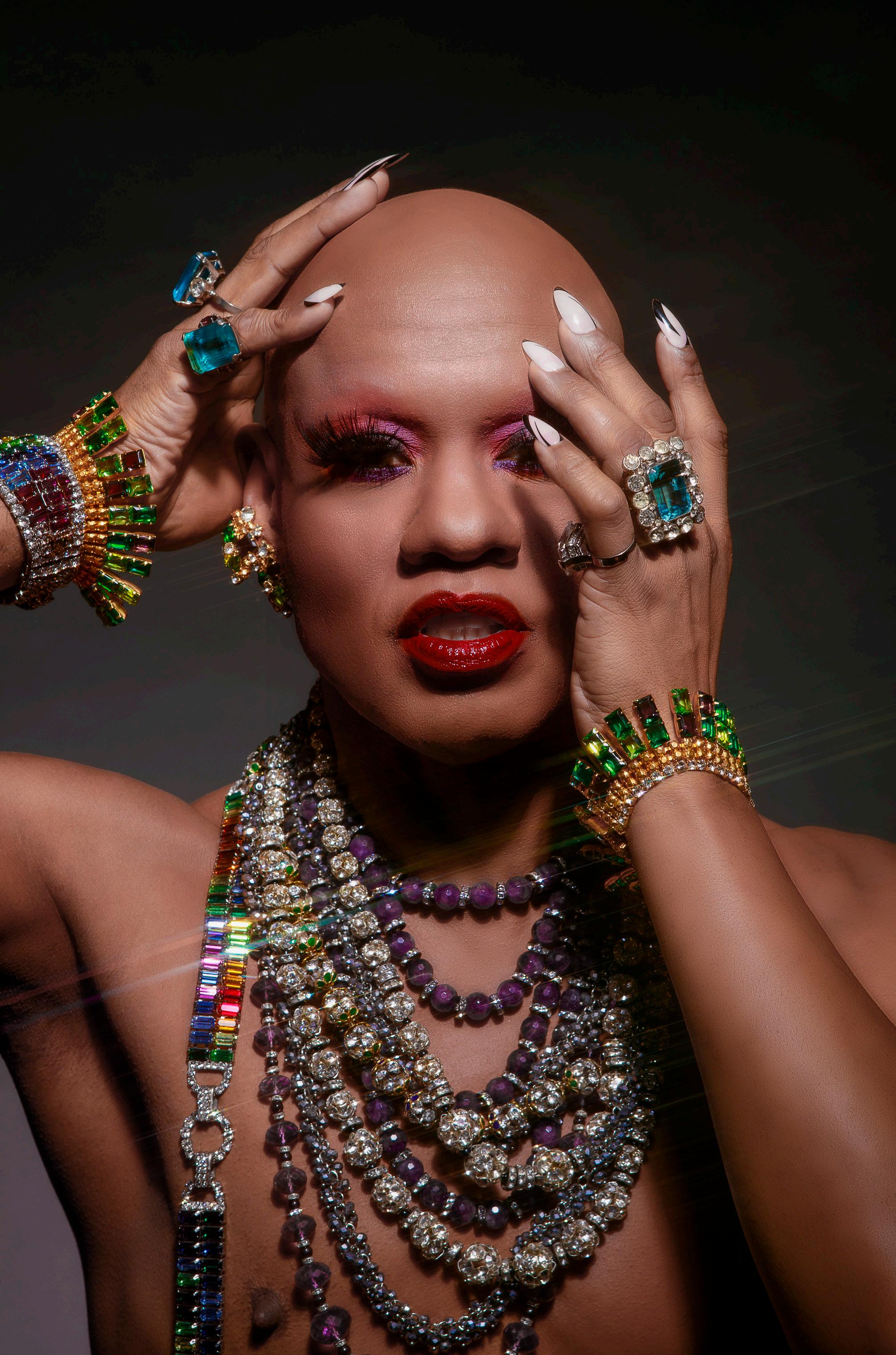 By Elio Iannacci
By Elio Iannacci
24 IN MAGAZINE JANUARY / FEBRUARY 2023 COVER
Photography by Thomas Evans Photography
Singer, songwriter, clubland acolyte, fashion icon, queer activist, DJ, drag artist. Kevin Aviance approves of all these loaded labels to describe who he’s been and what he’s been up to for most of his life. Yet what doesn’t befit the undisputable Queen of all Queens in the grand court of global nightlife is a description that penetrates so many of his profiles. It’s one word that the multi-hyphenate performer wants banned from this article entirely.
“You can call me he, she or them – I’ll take it all, but I’m warning you, girl,” Aviance says via Zoom, laughing and then pausing for effect before continuing his threat: “Do not call me a legend.”
Aviance’s tenor immediately takes me back to 2008, when I was fortunate enough to land an interview with the equally-as-intense Eartha Kitt. In the midst of our chat, I foolishly used the L word, and Kitt – then 81 years old with no purrs to give – looked me straight in the eye and said, “Dearie, let’s get something straight. I’m not the stuff of legends and I’m not an antique – I’m forever!”
This same adage applies to Aviance. When he moved from his hometown of Richmond, Va., to Washington and changed his name from Eric Snead to Kevin Aviance after joining the House of Aviance (one of the grand vogue houses emerging from LGBTQ2IA+ ballroom culture), our club scene got disrupted and disturbed in the best of ways. Aviance’s mere presence – he stands six foot two without heels, refuses wigs of any kind, and prefers DIY or couture to pageantry coronation-style workwear – rang in a new era of queer artistry and made a space on the dance floor where the multicultural and multi-critical could live, breathe and party together.
and Arena, and a slew of singles and remixes followed Aviance’s moment with Madge, all of which is covered in an award-winning 2015 documentary by Canadian filmmaker Raymond Helkio titled WERK. FIERCE. OVAH. Aviance! Yet with a performer of Aviance’s stature, it is often the stolen, spontaneous moments that haven’t been captured on film or iPhone that convey his epic energy.
I’ve been lucky enough to be a first-hand witness to Aviance’s exquisite extra-ness in multiple cities. I’ve seen him rage on top of an estate home on Fire Island, fearlessly strutting on dangerously angled roof shingles in high heels, and bursting into a lip-synch of “I’m Not Telling You” just before a sour DJ pulled the plug on his performance, claiming it didn’t jive with her “dark” set. I’ve seen Aviance play Halsted Market Days in Chicago, and turn out a gospel-like version of “Alive” in the parking lot of a 7-11, treating the rickety convenience store stage as if it were a pulpit while singing to a wide-eyed, Slurpee-sipping, shriek-filled midwestern gay audience like they were parishioners.
But I’ve also observed Aviance basking at his best: in pricey highproduction, swathed in avant-garde lighting and video, surrounded by hundreds of devoted, shirtless men mushed together on the dance floors of Toronto’s now-defunct Warehouse, New York’s legendary Roxy and Montreal’s ever-resilient Stereo. It is in these spaces where I noticed Aviance’s followers were entranced by his theatricality, gasping in the basslines of songs such as “Din Da Da” and “Rhythm Is My Bitch,” and feeding off Aviance’s every breath, pant and growl.
Few can contest that Aviance’s status in pop culture isn’t legendary. Beyoncé reconfirmed this last year when she put the spotlight on Aviance by sampling, interpolating, rearranging and revocalizing his signature hit “Cunty,” his underground dance track of 1999. This all occurred after Aviance left Washington for New York City, was booked in major clubs by Suzanne Barsche and Junior Vasquez and, in 1994 (when Beyoncé was just 13 years old), was given the biggest of breaks by Madonna. It was her foresight in casting Aviance in her video to “Secret” that made him realize what kind of possibilities were out there for him. Two albums, nextlevel spectacles at historic clubs such as The Soundfactory, Twilo
Let’s start with a huge question: what would you say has been your most memorable performance to date?
I have a few. I remember when [DJ] Junior [Vasquez] played “The Pressure” by Sounds of Blackness and the spotlight hit me and I was wearing overalls and platforms and just danced my ass off. The crowd literally went wild – it was just like a scene in a movie. Junior was living for it so much that he came down from the DJ booth and handed me flowers. I also dressed up like a Black Marilyn Monroe for Junior’s birthday party at the Soundfactory, and that was something for the books. We had moments. Big moments.
When listening to the rest of Aviance’s oeuvre, you can hear that the cycle of clubland victories and dramas he’s experienced are the lifeblood of his songs. These experiences are embedded in the language of his lyrics and reflect his own excavation of what it means to be queer, Black and phenomenally fierce (listen to his 2015 EP RAW for proof). Which is why it makes all the sense in the world that he is releasing a family of tracks this year that aim to re-examine his past and reinforce his future under the mirror ball. There is also an in-the-works Aviance autobiography currently getting sorted and slated for a quick release. These two projects – which follow Aviance’s 2022 anthem, “I’m Back,” and his new cover of the historic house anthem, “I Will House You” – aim to further build on Aviance’s already-majestic dynasty.
Moments before he Ubered to the airport for yet another headlining gig abroad, I spoke with Aviance about the peaks and valleys of his empire.
Which moments would you say were life-changing?
I’ll never forget this one because it was pure drama. Junior could be nasty, too. He made me wait for hours in his club to perform ‘Cunty’ and he had that song before anyone else and held on to it for weeks and wouldn’t play it. Nobody had heard it yet and I was waiting, waiting, waiting, and showing up every weekend expecting him to play it and perform it. One night, someone told me he would finally play the song [but] I’d had it and decided to leave. Just as I was getting out of the club, I heard the ‘Cunty’ beats and ran back inside to turn it out. That song was a turning point in my career. It changed everything.
25 COVER
“IF YOU DON’T LIKE WHO YOU ARE, NO ONE’S GOING TO.”
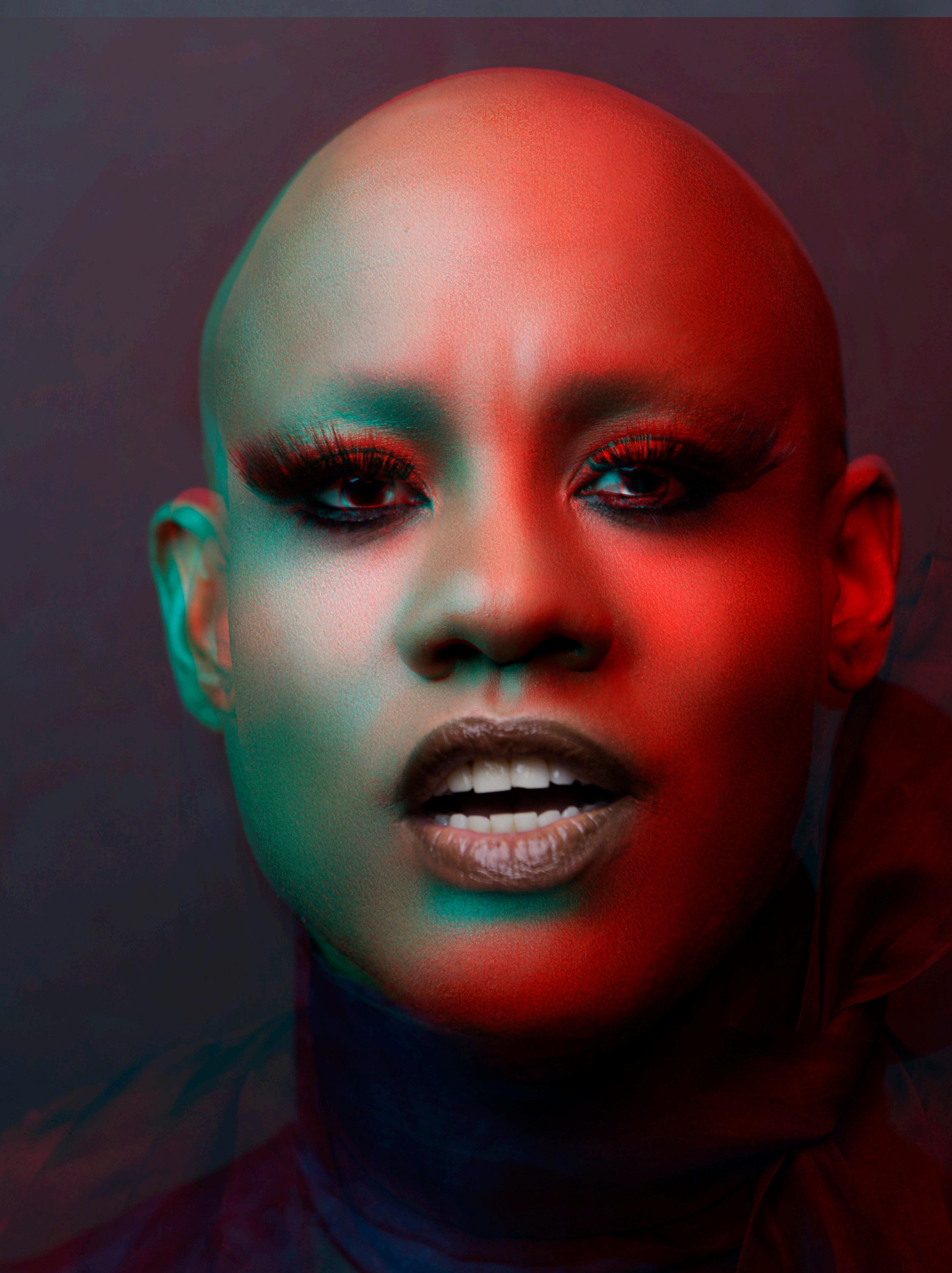
COVER
It is hailed as the ultimate bitch track in music history. What, in your opinion, makes a good bitch track?
A bitch track is a personal testimony of how you really feel at that moment in time. All the rage and the self-confidence, you know? You have to understand that so many were shaming us for being queer. The bitch track was dangerous to the shamers, it plays with gender. Guys were supposed to be masculine and shaking their dicks around, and bitch tracks celebrated being effeminate, Black, femme, gay and holding up that feminine power. To me, ‘Cunty’ is not negative at all; it’s the opposite. It’s an anointment – it is me saying no one can stop me, I’m feeling beautiful, fierce, powerful and I need to be celebrated.
In some ways, it feels like ‘Cunty’ is a battle cry as well. Is it? Yes. Against all the people shaming us. Shaming us for being queer. Shaming us for being faggoty. Shaming us for having a Kiki. Shaming us for feeling strong among each other. We should be able to celebrate each other, and be anywhere and anything we want to be. I’m glad people want to reuse ‘Cunty’ and talk about it. This track used to be more underground but now people are calling it a classic. It’s become textbook and academic, and I’m in history now because of this shit, okay? So, yeah, there is a kind of revenge that’s happening that I like.
The song, it’s dangerous. Guys were supposed to only be masculine, to have their dicks swinging to be powerful, but then I heard these two kids talking at The Pier in New York and one of them was looking into a broken mirror and I heard him say to his friend, ‘Girl, I’m cunty.’ He was feeling himself and his power. Feminine, masculine, all of it mixed up. So I brought it to the studio.
Your costumes often look like couture and represent eras of queer nightlife. Have you ever thought about curating them for an exhibit?
I kept a lot of the gorgeous stuff, some hats and some feathers, but a lot of it was so spur of the moment – all that spandex is gone. There is some fierce footage of me in a bunch of different outfits which I’m currently trying to find some way to bring it to life again in a way that it’s interesting. But you’re right. It needs to be documented. Right now, I’m searching for videotapes and just asking for [them from] all the people who have taped me that I never knew about. Pictures ain’t no problem – they have been fun to find – but I am all about movement. If you see the way I work the clothes, that, to me, is me living in the design.
What have you worn lately that has made you feel the same way? I just did a photo shoot with Interview magazine and it was incredible. The stylist pulled this Marc Jacobs dress: it’s like a garbage bag with tulle. It is so intense. You know when you feel like you’re in just the right place at the right time? Like, this is where you should be? This is where my heart is? That is what it felt like for me wearing this piece. It was art on my body and my body responding to the art. I live for fashion. I live for the art of fashion, and to be able to perform in couture and ready-to-wear. Art on art, honey!
Tell me about the energy you feel between the style you see on catwalks versus what you see in fashion shows. Is it the same?
Runway in clubs and runway in a show are two different things. One is future, one is present. One is real. One is a copy. Do you know what I mean? I like seeing all this attitude, this gayness, the fierceness on a fashion catwalk, but we know where it comes from.
I know this is painful to talk about – and we don’t have to – but how has the rapport you’ve had with your fans changed after you were assaulted by a group of homophobic men in 2006 [who were subsequently charged with hate crimes]? No, I want to talk about it. Listen, I live for applause. I live for that whole act of performance, that whole, ‘yeah, work, girl, work,’ all that stuff. I knew fans were sorry about what happened to me, but it was hard to respond. They were happy that I was still alive, but I’m sitting there with my mouth wired shut because of how bad the beatings were and what those men did to my jaw and face and body. Performing was everything to me, and then I basically lost my career for years. I couldn’t do anything professionally. I went to rehab, I tried to self-medicate, I didn’t know anything about PTSD or all the things that happen to your mind and body after you’ve been attacked. I tried to get help for myself, and I was killing myself, actually…and I didn’t know that. At one point I was 115 pounds, just trying to breathe. I tried to put makeup on my face, and I couldn’t even see but one side of my face. It took way too long to come back and I think I’m still doing it. This next year will be a fresh start because we are also getting out of COVID and monkeypox, so I’m hopeful.
Beyoncé’s Renaissance – which you are sampled on – is a reason to know that you are so beloved. Do you see her record as an homage to queer culture and queer heroes?
Yes. Definitely. She’s celebrating her gay uncle and the way she does it isn’t sad, it’s a Kiki. There is gay lingo in it. There is Black gay lingo in it. Our history is literally on her record if you listen closely. She had some time on her hands and she thought about her gay Uncle Johnny and how she would not be where she is right now if it wasn’t for him. Black gay people are in a renaissance right now. She sees it, and this album talks about how this moment and these people are influencing her.
Now that you’re working on your next album, have you been revisiting your debut disc and looking at your process recording it?
Oh yes. Box of Chocolates started out as a complete blank slate – it was exciting. I was growing as I was working on it. It all happened because a wonderful French fan went to DJ François K and she sold me to him. When I signed the contract, I asked him, ‘What am I going to be?’ He said, ‘Whatever you want.’ That’s when you know you are with a genius. He kept on me. He said, ‘Whatever you need to say, this is the time to do it.’ I think about that now when I’m making music.
When I was doing [Box of Chocolates], I also learned what my actual style was. I thought I didn’t know how to punctuate, I didn’t know how to round my mouth or approach the vocals, but this student at Berklee College of Music was in the studio with us and he told me that my enunciation was already giving him jazz. He said I was already scatting the lyrics and it sounded amazing, so I trusted him and fell in love with scatting. I just applied it to dance music and it became my thing.
27
COVER
The way you sing on the track ‘Join The Chant’ is the opposite of jazz. It’s so guttural and baritone and supernatural sounding. Where did that come from?
It was because I love alternative music so much and I saw Black people weren’t doing any of it so I wanted to do it, include myself in the equation. I love Siouxsie Sioux and The Cure and the dark goth vocals that they were serving, because that was what I was so into. I still am, I live for Siouxsie Sioux. What Siouxsie Sioux did for punk, I wanted to do for dance music: give it dimension, something sexual and sensual, give it personality and soul and give it a Black twist and give it more glamour. I wanted to translate punk for people like me, for queer people…because just existing makes us radical. Just us breathing makes us rebellious. Whether we know or not, we are more punk than punk.
I’m wondering about heroes you came across before and after you became Kevin Aviance. Tell me about the first time you saw Boy George.
I was in ninth grade and I saw him on TV and it was like my life stopped. The voice, the makeup, the moves, the clothes. It was so different to me. The kind of energy coming around that – masculine, feminine, somewhere in between but beautiful and soulful – it turned me on to the idea of what I could do. Watching him turned me on to myself.
Grace Jones is also someone that you’ve mentioned helped you envision your own future. What was it like performing for her? Intense. She’s my ultimate inspiration and her One Man Show is the pinnacle for me. I remember I got 20 foxtails and made a jacket out of them for the event – it was for her boyfriend’s birthday party at the time. Anyway, I put a record on my head like a hat, and I performed her song ‘Do or Die.’ While I’m doing the performance, Grace takes her scarf and she puts it over her face. I was gagging. I still am.
When you were cast by Madonna for the video to ‘Secret,’ did you leave set with any lesson?
Yes. On how to make sure your vision is executed to perfection. She called me into her dressing area and quickly asked for Wardrobe and restyled me on the spot. She told the stylists to use all the gold jewellery they had laid out for her, for my character. So I wore all of the gold that was supposed to be for her. I’ll never forget it, because she looked me up and down and said, ‘Why are his tits so big? He’s not a hooker on the street. He’s a call girl. There’s a big difference.’ The costume person said they didn’t have a bra for me and Madonna said, ‘Well, make it!’ and said she wasn’t leaving until she saw my full look with the bra. So they had to make the bra in 20 minutes because Madonna was on a schedule and because, well, she’s Madonna.
Being there with Madonna made me know right then and there, if you’re involved in something that is your project, you’ve got to be involved in every detail. I learned that you have to get exactly what you want and you can’t let anyone tell you what you want.
How do you think growing up queer without Grindr or dating apps differentiates you?

First of all, when I started going to clubs, nobody was scrolling on Grindr. We were Grindr. Live. No texts, just talk. I think because
of that, I know how to cruise and it is the skill of a lifetime. I can cruise a crowd when I’m on the stage or cruise someone I see who is beautiful to me. It’s all the same. If you are on your phone all day, you won’t learn how to perform or be engaged. That’s why it’s called sexually active! Experience means everything. There’s no way anything’s going to get through to you if you don’t at least see it, feel it, touch it, do something.
What are the benefits of working on your charm?
If you don’t like who you are, no one’s going to. No one’s going to beat off on you, girl. I don’t care what you look like or what you do. If you got the biggest dick or the loveliest lips or whatever... that don’t mean shit.
What do the next few months of 2023 look like for you?
I have a project called Black Queen. These songs are great because they give tribute to the language of Queendom and to getting what you deserve. One song is called ‘Gul Get Ur Life.’ I also have a cover of Michael Jackson’s ‘Working Day and Night’ that I love. This album is a home for all of those songs that didn’t have a home that need a house. I’ll be including new songs like ‘Hold on Me,’ ‘Sushi Darling’ [with The Cucaracha] and ‘Mary had a Little Lamb’ [with DJ Samurai]. Part of the project will be new mixes of older stuff, too, because in everything I do, I love looking back as much as I love looking forward.
28 IN MAGAZINE JANUARY / FEBRUARY 2023 ELIO IANNACCI is an award-winning arts reporter and graduate student at York University whose research interests include ethnomusicology and gender studies. He has contributed to more than 80 publications worldwide, profiling icons such as Barbra Streisand, Lady Gaga, Aretha Franklin and Beyoncé. His academic work is supported in part by funding from the Social Sciences and Humanities Research Council.
COVER

COVER
You Need to Add
CMAT To Your 2023 Playlists
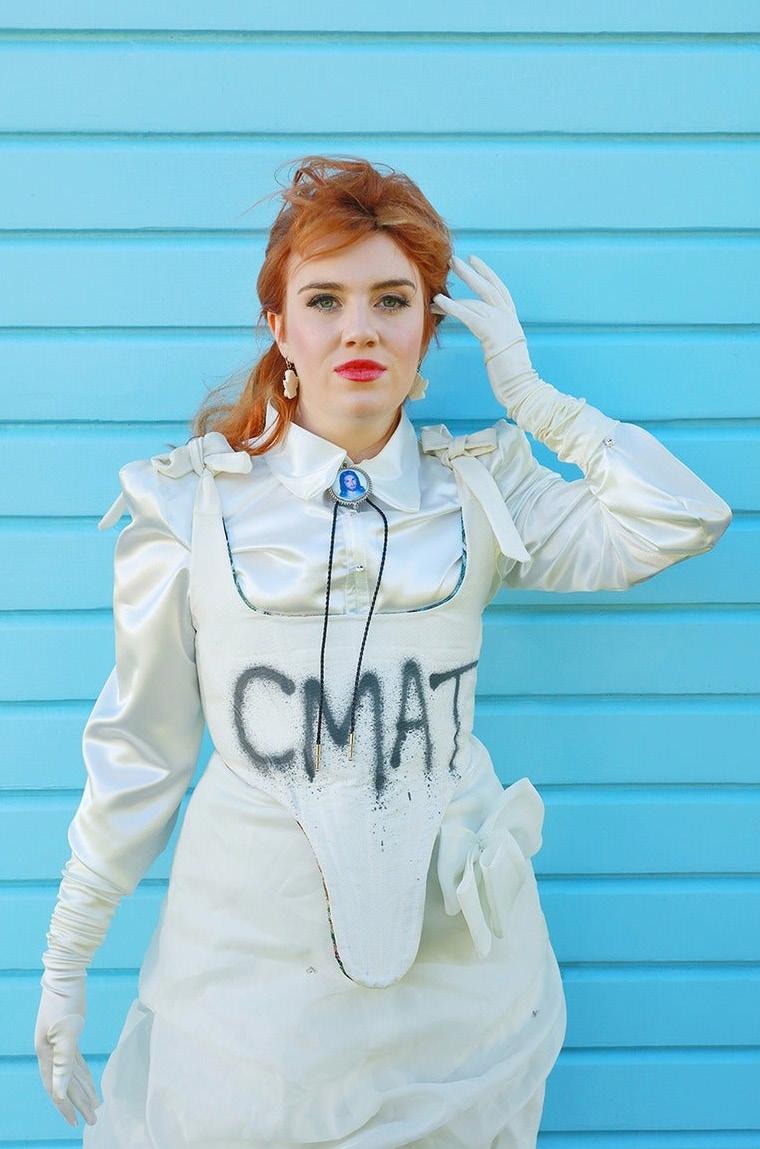
Irish teen pop sensation has taken the world by storm with her beautiful vocals and witty lyricism
By Rowan O’Brien
30 IN MAGAZINE JANUARY / FEBRUARY 2023
MUSIC
Why
I first came across CMAT through the greatest music recommendation tool of the 21st century: TikTok. The video that popped up on my For You Page wasn’t promoting a new song, however, but was instead a charming Irish woman commenting on the music industry. Her magnetism intrigued me and within seconds I had opened Spotify and clicked on one of her top songs, “I Wanna Be a Cowboy, Baby!” Ever since her hauntingly beautiful vocals and witty lyricism hit my ears, I haven’t been able to get her out of my head.
I flew into an internet frenzy, consuming all the information I could about the new love of my life. I learned that Ciara Mary-Alice Thompson, also known as CMAT, is a self-proclaimed “Global Celebrity Teen Pop Sensation From Ireland” who has declared that everything she does is for the girls and the gays. Her debut album, If My Wife Knew I’d be Dead!, entered the Irish charts at number one in February 2022, and since then she has taken the world by storm on several sold-out tours.
CMAT’s concerts draw huge crowds of sparkling pink that swarm the stage. In Europe, she performs for throngs of people at outdoor festivals and large venues like the Royal Islington Club in London, England, and the Olympia Theatre in Dublin, while her (sold-out) Toronto show took place at the cozier Monarch Tavern. Though I loved the intimacy this offered, I couldn’t help but notice the difference in venue compared to CMAT’s performances across the pond. This proved my theory; most Canadians were ignorant of the illustrious power of this Irish import! Consider this your sign to succumb to mad CMAT disease before she gets so big that an Unnamed Ticket Site oversells her show during the presale.
CMAT’s music mixes infectious pop beats with honky-tonk charm, inducing the need to dance unabashedly under rainbow strobe lights. Whether it’s a pop bop or folksy ballad, you can’t help but sing along through tears as her melodic voice contemplates listlessness and loneliness. No matter how unassumingly fun CMAT’s lyrics may seem on the surface level, they have the ability to pierce straight through to your soul. For example, while her song “Nashville” may seem to be a melancholic goodbye as she moves away from her friends, the underlying emotional resonance hints at something darker. CMAT has spoken about her struggle with depression and how this song was inspired by someone who threw a going-away party so they could say goodbye to their friends and family before killing themself.
Perhaps it is her Irish sense of humour, but somehow CMAT is able to perfectly intertwine sorrow and cheekiness. Nestled between the swirl of emotions in her music, queerness peaks through her lyrics as a subtle wink to her comrades. In a love ballad to 1960s American actor Peter Bogdanovich, CMAT tells him, “If I wasn’t in need of a pawn to take the world, I’d probably be with [your wife].” On the other hand, “I’d Want U” is a song of adoration, if not love, for a girl that CMAT met at a house party.
What is more queer than a song about swearing off a particular Zodiac sign? In the music video for “No More Virgos,” CMAT pursues a mustachioed Virgo while her friend group of Irish drag queens – Lavender, Viola Gayvis and Maura Darragh – attempt to dissuade her from repeating romantic mistakes. Not only is
the charade entertaining in its own right, it is a great example of how CMAT creates space to uplift other queer artists in her work.
CMAT’s music videos combine a Wes Andersonian attention to mise en scène with the messy camp of the ’80s. If you explore her YouTube channel, chances are you’ll come across puppets, group numbers with oddly mesmerizing dance moves, and hair “going high as heaven.” In the music video for “Peter Bogdanovich,” CMAT dresses in drag as the eponymous actor navigating an affair on a black-and-white sound stage, and dances with a puppet as the two women vying for his heart share a tender kiss.
Despite appearing charmingly chaotic, CMAT’s refined aesthetic emanates through every aspect of her art, from her music and videos to her funky style that pays homage to queer country icons such as Dolly Parton and Loretta Lynn. Josephine Baker was well known for pulling silly faces, or “mugging,” to inject humour into her performances and gain agency over the way she was viewed by onlookers, and this technique can be seen in both CMAT’s music videos and in-person shows. Her boldly coloured eyeshadow makes her eyes pop as she engages the audience with a story told by her overly exaggerated facial expressions and envelops them into her sense of humour and emotional journey.
Recently, CMAT was set to perform on the main stage at the All Together Now Festival in Ireland when she found out that a TERF had been invited to speak at the event. She took to Instagram and wrote a lengthy story saying, “the entire experience has been tarnished knowing that members of the trans community attending the festival have been made to feel unsafe and unwelcome.” CMAT discussed being unsure of whether or not she should perform, going on to say, “it is really not in my nature to cause problems for my team or festival organizers, especially while everyone in music is still struggling post covid, but i also cannot stand by while people are *literally* getting paid to bully members of the lgbt+ community. my community.” All Together Now then posted an apology on Instagram, and the next day CMAT performed to a huge crowd with a ginormous trans flag emblazoned behind her.
Back home last fall, the air of the Monarch Tavern crackled around me as I waited by the edge of the stage for CMAT to appear. I wore a cow-print two-piece set with a pink cowboy hat and boots to match – something ridiculous but chic enough to make CMAT proud. She came onstage in a tornado of verve and good vibes, throwing her all into every lyric and playing games with the audience between songs. She would later post an apology on Instagram for not meeting people after the show because she was feeling very ill from exhaustion and almost passed out during a number. If that was CMAT on low battery mode, my brain cannot conceptualize how much energy must pour out of that charismatic redhead when she’s feeling 100 per cent.
I realize I may be shooting myself in the foot by encouraging all of you to check out CMAT, and with every word I write I risk not being able to get tickets to her next show. However, I believe it is more important to share her infectious artistry with as many people as possible, as her wacky yet elegant art can resonate with anyone who is feeling down but still wants to dance. Just share your presale code with me.
ROWAN O’BRIEN is a queer writer and filmmaker based in Toronto who loves ranting about LGBTQ+ representation in media while creating their own queer stories. Their queer coming-of-age short film Crushed played at the Toronto Youth Shorts festival, and their next short film, City Limits, will be released this year.
31
MUSIC
Getting To Know Sugar High’s Adam Fox
We sit down with the openly gay actor to chat about coming out, role models, his first acting gig, the upcoming TV show, and much more
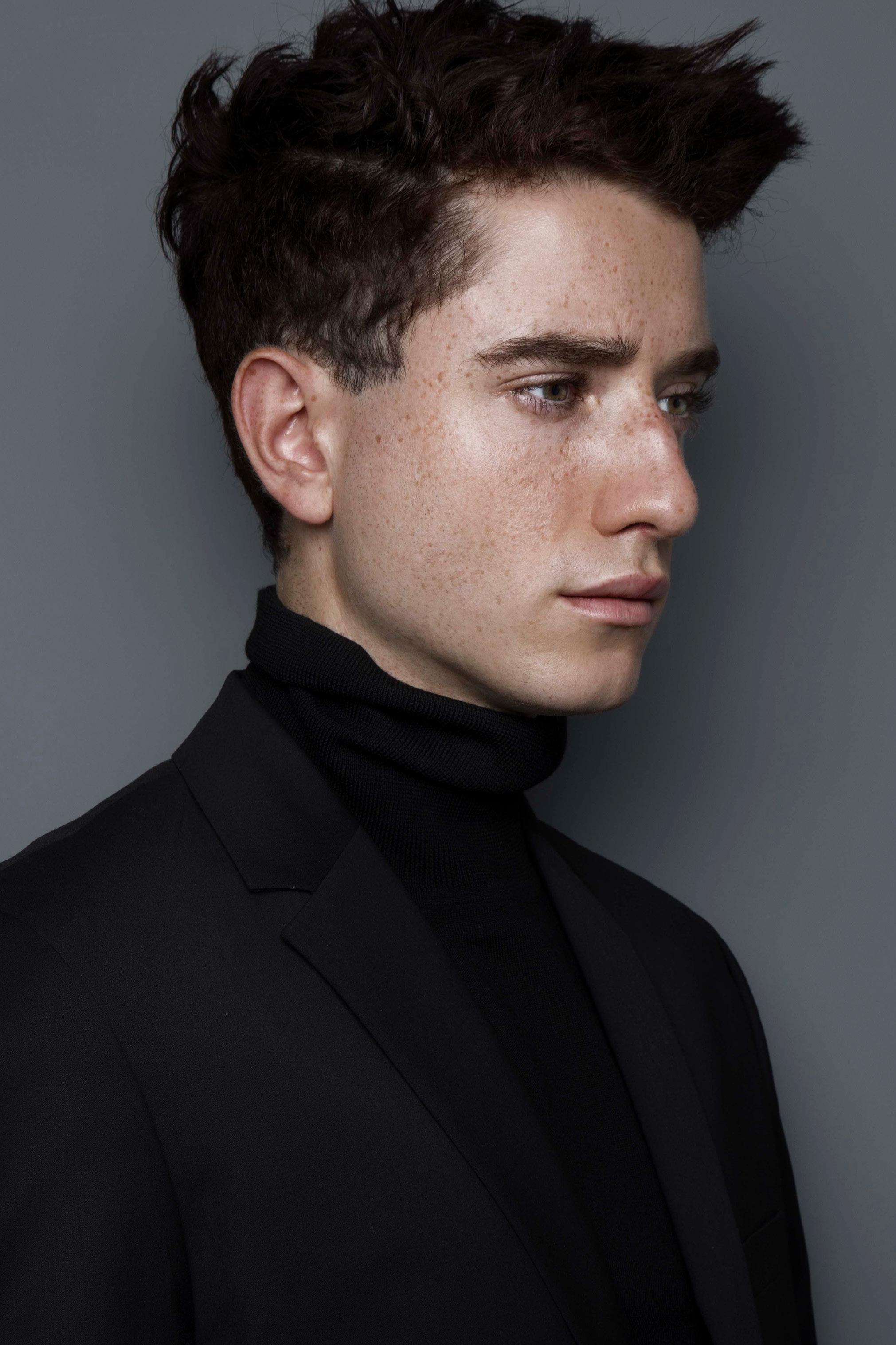 By Christopher Turner
By Christopher Turner
32 IN MAGAZINE JANUARY / FEBRUARY 2023 TELEVISION
Photo by Dannyson Pham
One of the most anticipated shows to hit LGBTQ+ specialty network OUTtv in recent memory is Sugar Highs, a lighthearted comedy about three men in their 20s who vie to find sugar daddies to get out of working for a living. The leader of the pack and the brains behind the operation is Bud, played by Adam Fox, an actor, writer and director from Vancouver.
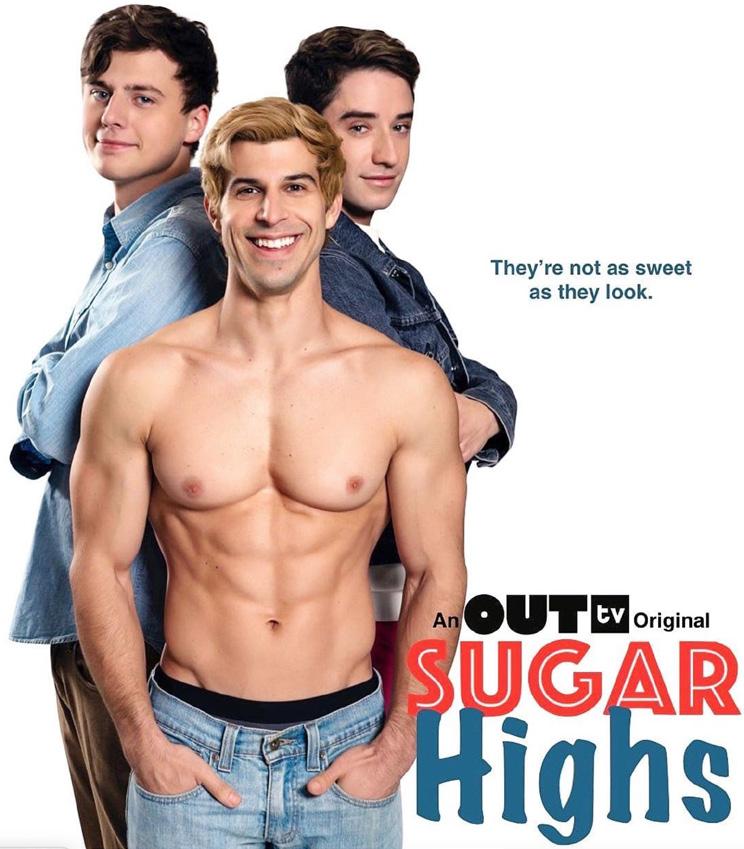
Raised in a creative, unconventional household, Fox attended McGill University for one year before moving to New York to pursue acting and complete a BFA degree at New York University for acting, where he was placed in the Stella Adler Studio. Since graduating, Fox has performed, directed and worked behind the scenes in over a dozen studio and independent projects, but OUTtv’s original six-episode series Sugar Highs is his biggest role to date. We sat down with him recently to get the scoop on his first big role, what Sugar Highs is all about, and much more.
Let’s kick things off and talk about Sugar Highs! What can you tell us about the series?
So imagine any fun roommate comedy (How I Met Your Mother, Friends) but then make it gay and add sugar daddies – sounds like fun, right? Basically, the series follows Bud, Mickey and Tab, three roommates who are struggling to make it in San Francisco and survive in today’s economy. Solution? They all find sugar daddies (and mommies). But trading love for money is never that simple, and a roller coaster of events ensues. It’s part comedy, part drama, but also part coming of age. I say the latter because all three characters are in their early 20s, and they begin their sugar baby journey at a formative age. All their experiences – good, bad or indifferent – will leave a mark on their minds and change the way they look at life from there on out. It’s a journey that yields some growth, some success and a lot of failures, where they come to learn that, in fact, the life of a sugar baby is not always so sweet.
What can you tell us about your character Bud, the brains behind the operation?
Bud is a musical theatre gay, with a twist. He is resourceful, determined, bold, naive, and at times ridiculous and brazen – it’s a fun combo. Bud gets the idea to find a sugar daddy after hooking up with his dance-class crush, who says he can afford his beautiful apartment because of his ‘daddy.’ That subplot is a whole comedy of errors – watch to find out – but nonetheless, it inspires Bud to sign himself and his roommates up on the Sugar App, at times against their consent. Bud takes on the role of pimp and matriarch, commanding Tab and Mickey while also looking out for them. In spite of his sassy quips and cheeky reads towards his roommates, it’s clear that he really loves them and that they are his chosen family, and that was important to me as an actor to convey. Behind the sass, brazenness and insults is a guy who is desperate for connection, and who just wants to be loved without judgment.
What was it like working with legendary Canadian filmmaker Thom Fitzgerald? What kind of director is he?
It’s clear from his resumé that Thom is a maven at what he does, and getting to be the lead on one of his shows is a privilege that I don’t take for granted. For that reason, I was a little nervous to meet him in my Zoom callback, but we hit it off instantly, and I knew we would have a great working relationship on the show.
What surprised me, however, was how much freedom I had in my role. There were days on end where I went without receiving any direction that wasn’t technical. Then there would be times where I had ideas that I worried were too outlandish, but he’d encourage me to try them. At the end of the day, if you show Thom that you have really put thought into your work, he will pretty much let you try anything.
What’s your favourite TV show (not including Sugar Highs)? It always changes, but my favourite show of recent years is Search Party from HBO. As a writer and actor myself, I admire shows that take risks and are willing to venture away from something typical. I love the way the show boldly oscillates between comedy and horror, and even into the obscene. In any given episode, I will be gasping in shock, then laughing minutes later. It’s such a wild ride and the characters are outrageous. It’s almost Brechtian in that it isn’t trying to present four likeable characters – if anything, they are very unlikeable.
In general, I’d say I get most excited by shows that make me think ‘how fun would it be to play one of those characters.’ It’s not an obvious choice, but I would one day really love to play a character similar to Search Party’s upstairs neighbour April, who is completely unhinged, erratic and wild. I just think that would be such a thrilling experience.
When did you come out? And what was that experience like for you?
So I actually came out as straight this year on April 1 in a very emotional video on my Instagram (@adamfoxofficial). Though I thought it was funny, I actually felt guilty because so many people believed me! I guess I am just that good of an actor. [laughs]
In reality, however, I came out at age 15. The whole coming-out journey was interesting for me. The truth is that if I’d been able to be in the closet and live more healthily, I probably would have stayed in the closet longer, but prior to coming out I was completely shut off: I had no friends at school from age 12 to 15, I wouldn’t participate in class because I was scared people would make fun of my voice, and it was stopping me from living life and being a
33
TELEVISION
good student. Even before coming out, I started forcing myself to talk to people, even if my voice stuttered initially out of anxiety, but I had to trust it was the only way to get better.
I had trouble saying ‘I’m gay’ or ‘I’m queer,’ so I had a classmate post a video on Facebook of myself dancing to a Britney Spears song, in addition to changing my Facebook to ‘interested in men.’ I got a LOT of mixed reception, and a lot of very mean My Honesty Box messages (may that app rest in peace, thank God), but I was able to start living freely. Very quickly I became part of the popular groups, and was even welcomed by the ‘Regina George’ of my high school, but it was quite jarring to go from having no friends to being in that group. Eventually, I found a good group of friends who were also popular, but a little bit more open-minded and made me feel celebrated. By the end of high school, I’d say I had a great relationship with my sexuality and felt pretty celebrated by my peers, in spite of a few inevitable haters.
Who do you consider a role model?
That’s always a tough one, but off the top of my head I’d say actress and acting teacher Sarah Redmond. Sarah is a working actor who has been in the industry for ages and still has this incredible attitude and endless kindness in her heart. I recall when I was younger, people would always tell me that one day I’d become jaded, and I always resented that. That’s why I think it’s helpful to have role models like Sarah, who has experienced a lot but still goes about life with a positive outlook. She was one of the first acting coaches I ever worked with and she always made me feel loved and special. One day I’d love to be able to have that impact on others…though I probably have too much innate Jewish cynicism to become quite as ethereal as she is. Even if I’m 10 per cent of her magic, I will be making a difference in the world.
What was your first acting gig?
My first acting gig was actually when I was working overseas as a model in Thailand. It was a commercial for a deodorant brand – I had never acted before and I was SO BAD and it was honestly mortifying. We basically just had to make animal noises and ogle as the female models walked by (cringe, I know), but I really had trouble coming out of my shell and having fun with it. Nowadays this kind of job would be a cakewalk for me, but Rome wasn’t built in a day and neither was I! Next time I have to ogle at women to sell deodorant, I promise to bring my A-game.
What are you most proud of?
So often I hear people say, ‘The moment you stop looking is when it happens,’ and my response to that is: NO! The way I have gotten anything I’ve wanted in life is by willing it into existence, and being extremely persistent and using any resource I have. My family is always commending me on how I am always somehow able to get what I want out of life. Everyone is different, but that’s what works for me and, frankly, I’m proud of how hard I’ve worked and for making my dreams come true. If you had told 15-year-old me that I would get to model overseas and then later in life be a lead actor on a TV show, I think you would have heard a gay gasp so loud you could hear it in China.
If you weren’t acting right now, what would you be doing? Masturbating. If not that, definitely writing. I was once introduced
to an extremely successful university dean who told me that after speaking with me, he felt I had the voice, outlook and mind of a writer. Though I didn’t go to school for it, what he said really stuck with me, and now I write all the time. I’ve always had a wild imagination and it only seems to get wilder with age.
One of the highlights of the pandemic was writing two full-length scripts and two shorts. A lot of these won’t come to fruition but that does not bother me, because it led to me feeling confident enough to pursue making my upcoming series The Sisterhood of the Traveling Wigs, which I have now found a great showrunner for, and it feels very likely that this dream will come true. One day I’d love to write a book too! The world is my oyster, and I’ll keep slurping.
What do you want people to know about you that they might not already know?
Unlike a lot of LGBTQ+ folks, and also actors, I have the privilege of having an extremely loving and supportive family behind me. A sad reality for a lot of LGBTQ+ folks, and also actors, is that they don’t have a great relationship with their family. I like talking about mine, not to boast, but because I think it’s great to give people hope, and know that one day even if their family does not support their identity, or even their career, that one day love may prevail and turn things around. Don’t get me wrong: like every family, we’ve had many ups and downs, but we’ve persevered and are closer than ever. They are truly my favourite people in the world, and nobody makes me laugh harder than my mom, especially when I am with my sister and we can both revel in my mom’s antics – I’m talking belly laughing and cheeks hurting.
In regards to Sugar Highs, they were the first people to watch it when it came out, and have been supporting it whole-heartedly – my dad even telling me that he felt the sex scenes were ‘appropriate’ and asking if I was comfortable sharing it with his friends. I like to call my parents ‘cool parents’ minus the trying to be cool part…. They are their own version of cool, who can handle watching sex scenes but still go to bed at 10 pm.
What’s next for you?
As I just finished filming Season 2 of Sugar Highs , I’ve been unavailable for most projects that have come my way in the last few months, so now that I’m done, I’m excited to get back in the game. My team and I have been looking over some amazing scripts recently and I’m excited to sink my teeth into something awesome. In addition to that, I recently signed a production agreement with a prominent Canadian showrunner for my upcoming series, The Sisterhood of the Traveling Wigs. The show is in its development stage, and if all goes well, we will be filming by Summer 2023! It’s super exciting to see my idea come to life.
Sugar Highs is currently streaming in Canada on OUTtv.com, the OUTtv Prime Video Channel and the OUTtv Apple TV Channel, and will be on the OUTtv broadcast channel sometime in the new year. In the United States, it streams on OUTtv.com, the OUTtv Apple TV Channel and OUTtv on The Roku Channel.
@Turnstylin.
34 IN MAGAZINE JANUARY / FEBRUARY 2023 TELEVISION
CHRISTOPHER TURNER acted as guest editor for this issue of IN Magazine. He is a Toronto-based writer, editor and lifelong fashionisto with a passion for pop culture and sneakers. Follow him on social media at
 Photo by Dannyson Pham
Photo by Dannyson Pham
SHOW ME… PORTRAIT SERIES
We asked everyone to come in their own clothes

36 IN MAGAZINE JANUARY / FEBRUARY 2023 FASHION
Ivan Otis HAIR STYLISTS: Brian Phillips, Jessie Ruthenberg (worldSALON) using WORLD Hair Skin (world.ca)
Carly
Tong (all from LeDrew Models); Janessa, Eilis James (both from Peggi LePage)
PHOTOGRAPHER:
MODELS:
Munro, Adonis Huggins, Moe Yousuf, Sofia Leon, Jasmine

37 FASHION
Carly
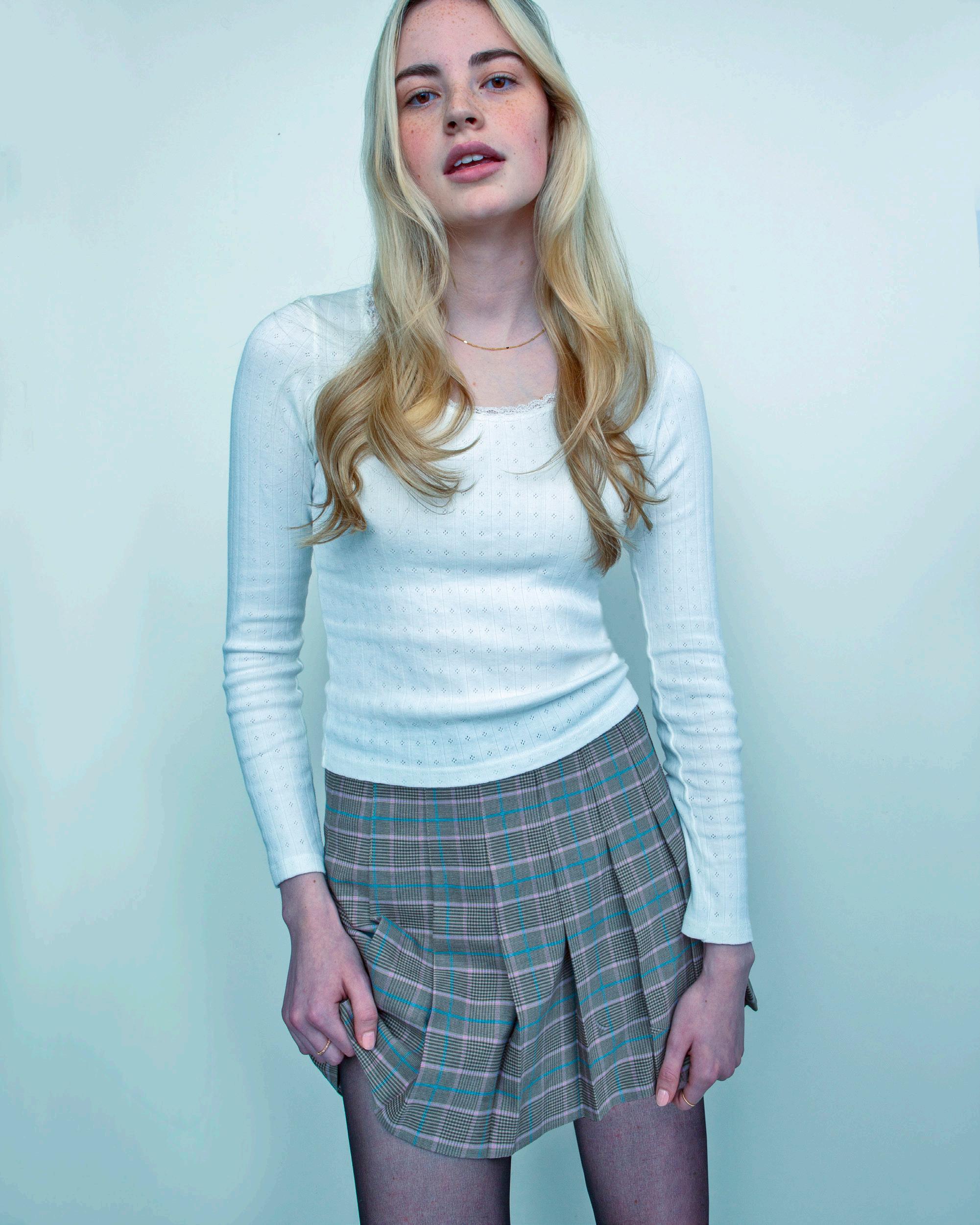
38 IN MAGAZINE JANUARY / FEBRUARY 2023 FASHION
“I like to be comfortable.”
TOP: Brandy Melville SKIRT: Aritzia
“This is what I wear when I’m dancing the Argentine Tango.”
JACKET AND PANTS: Made locally in Toronto
PASSION TANGO SHOES: Made in Mexico
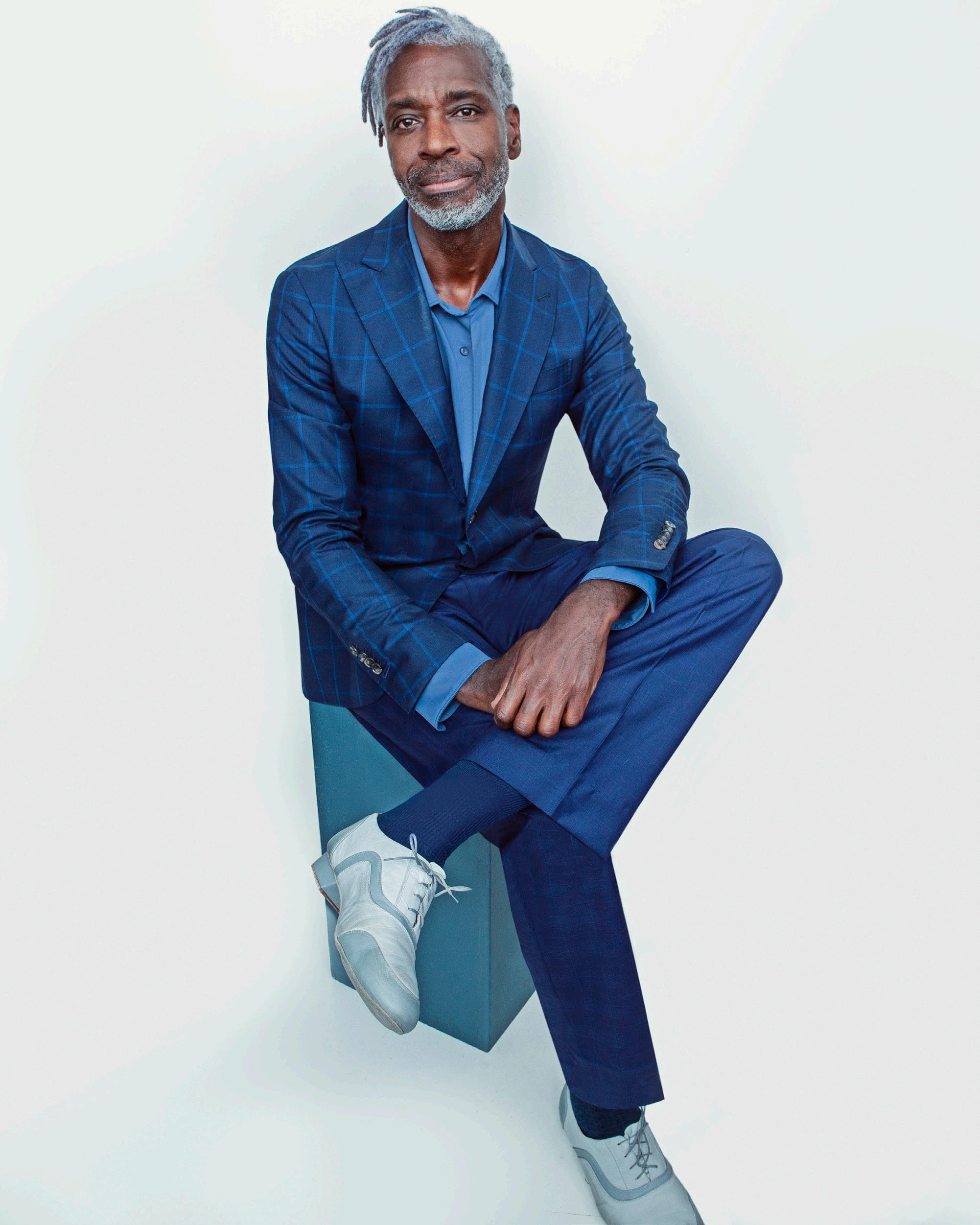
39 FASHION
Adonis
Jasmine
“I’m wearing thrifted clothes.”
T-SHIRT: (Unknown) Thrifted
PANTS: Lazypants

40 IN MAGAZINE JANUARY / FEBRUARY 2023 FASHION
Moe
“I write and play Neo Soul music.”
T-SHIRT: Kiss concert tee
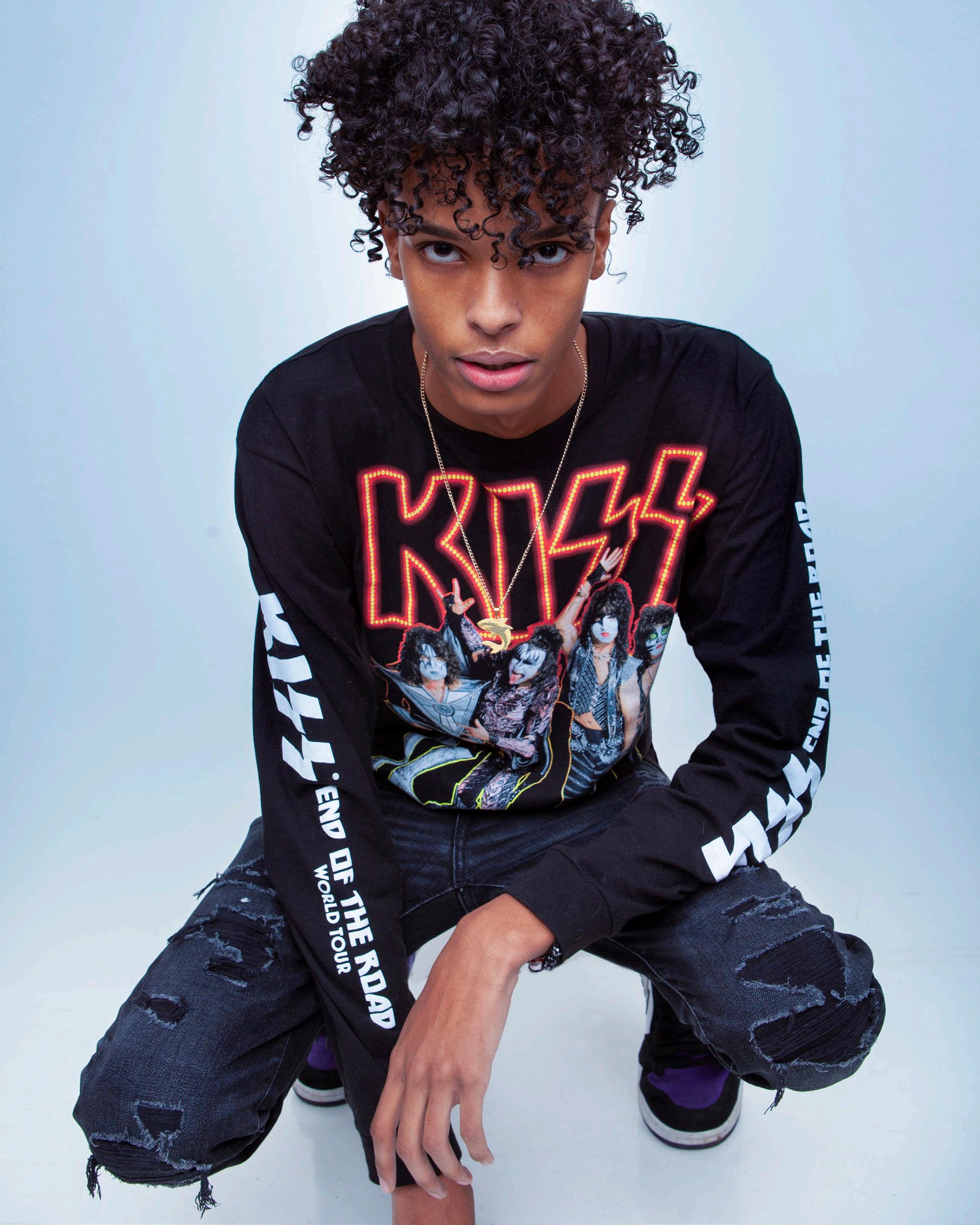
JEANS: American Eagle
SHOES: Air Jordan 1
41 FASHION
Sofia
LAYERED
JACKET: Zara
NECKLACE: Thrifted

42 IN MAGAZINE JANUARY / FEBRUARY 2023 FASHION
“I love to raid the family closets!”
TOPS: Mother’s vintage tops
“I’m wearing my sister’s clothes because my luggage was lost at the airport.”
SHIRT: Streetware Society
CARGO PANTS: Refuge
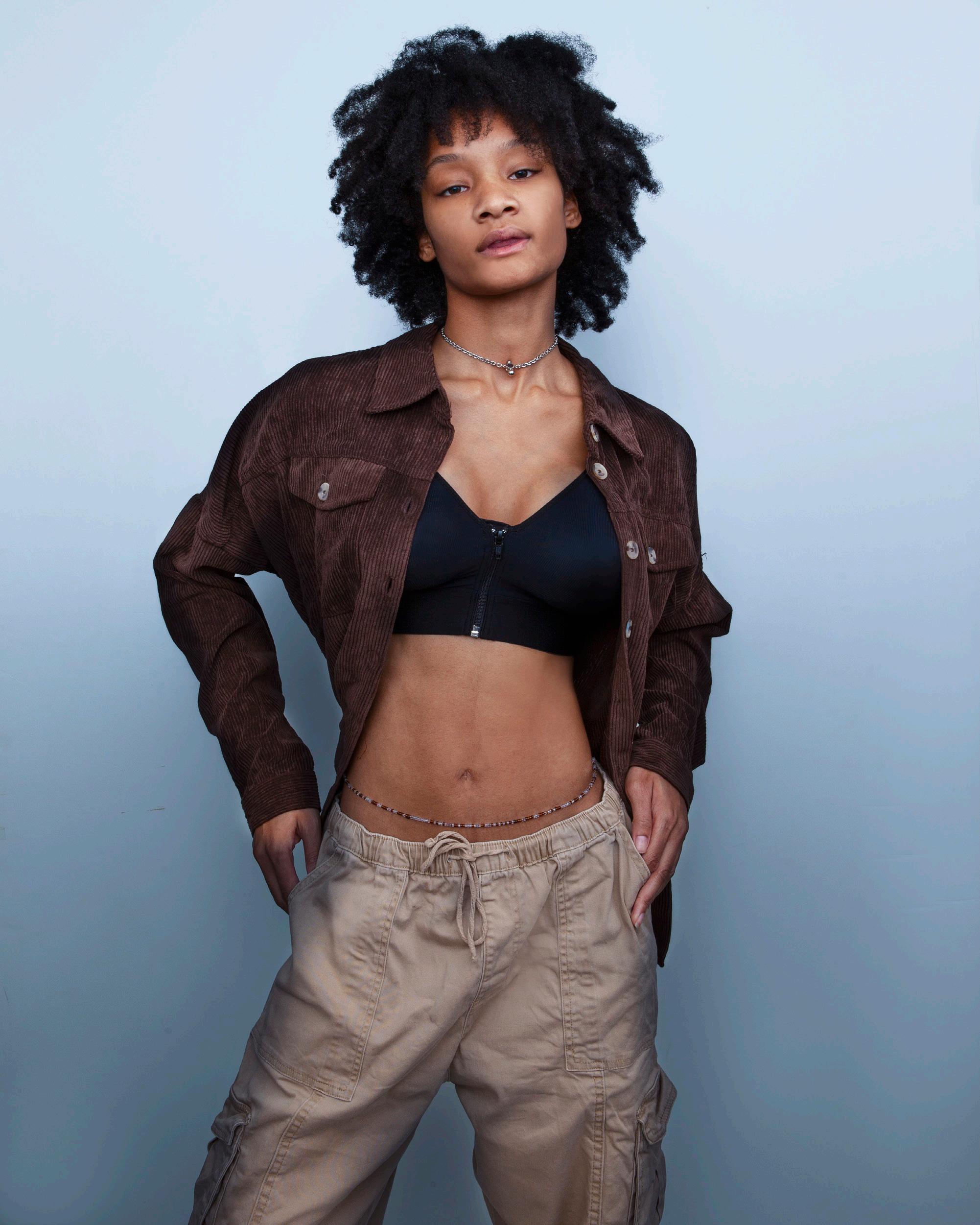
43 FASHION
Janessa
Eilis
“My name is Gaelic, pronounced AY-lish.”
JACKET: Vintage ’90s from Black Market in Toronto
TUBE TOP: Cut from a turtleneck
JEANS: Urban Outfitters
SHOES: Doc Martens
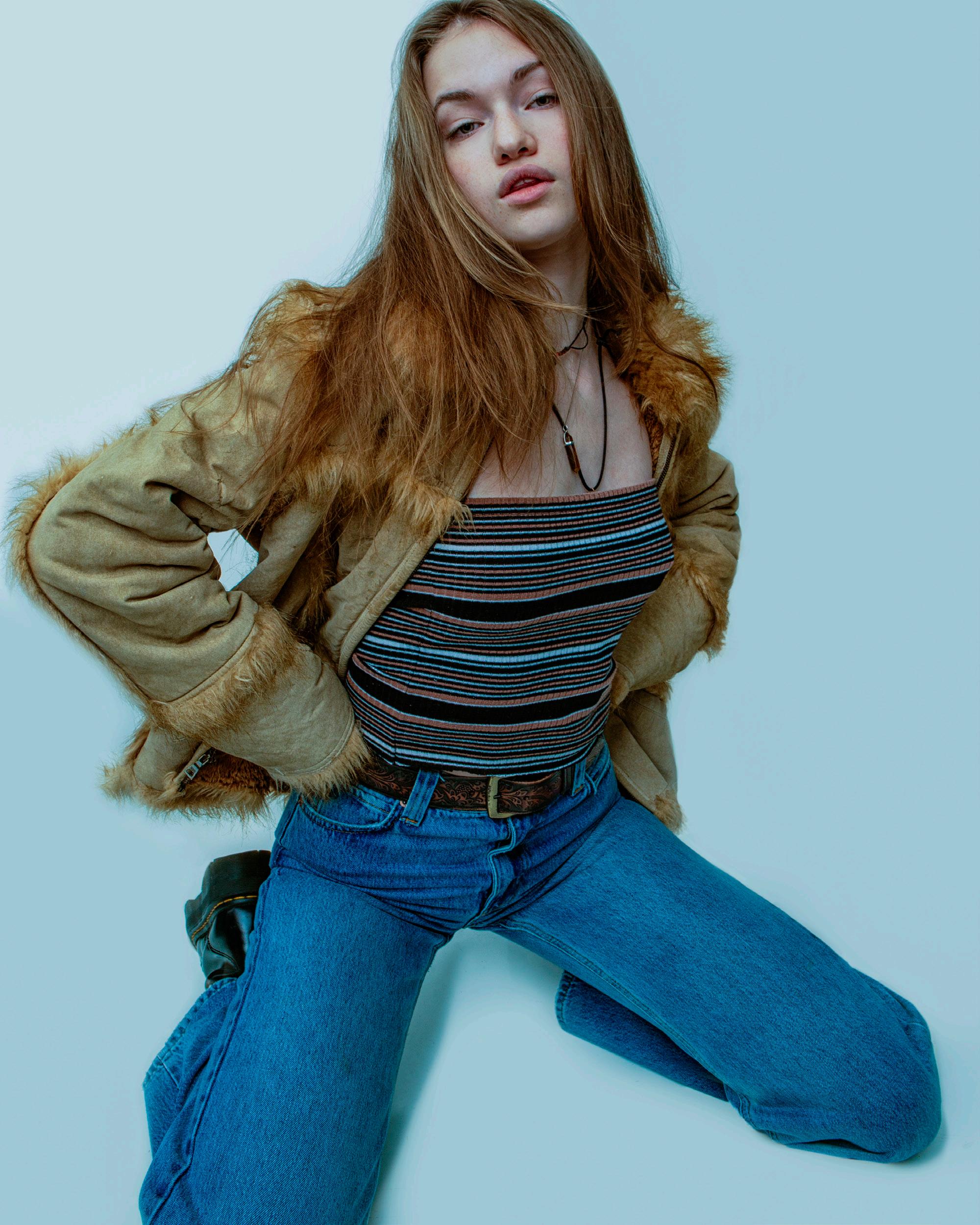
44 IN MAGAZINE JANUARY / FEBRUARY 2023 FASHION
Wearing a black top by Commence
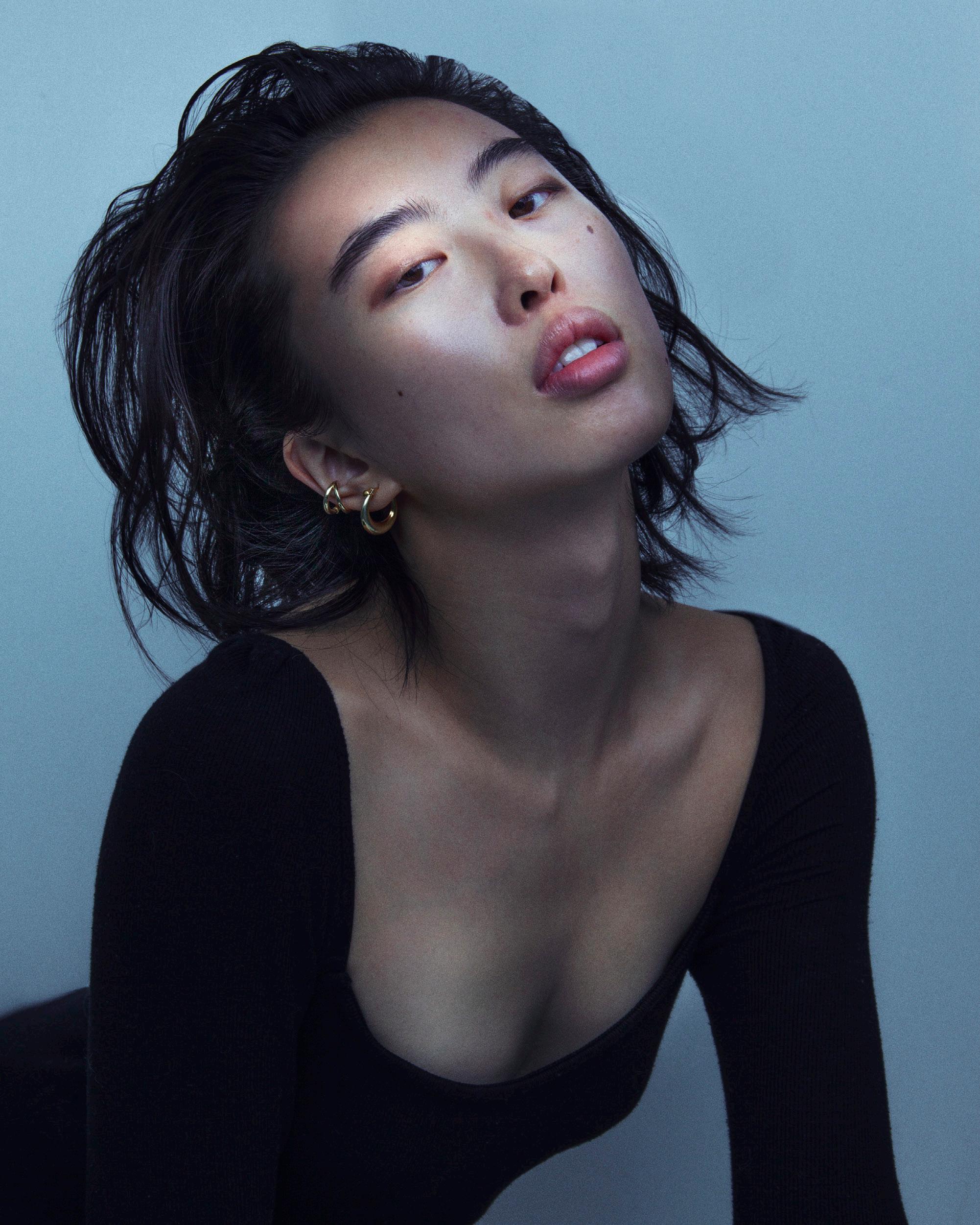
“This was a perfect fit.”
BLACK TOP: Commence
45 FASHION
Jasmine
The Books That Helped Me Figure Out Modern Queer Life
A list of books that helped shape my ideas about LGBTQ2+ culture, desires and life
By Paul Gallant
At age 93, Milan Kundera is perhaps our straightest living author, his male protagonists forever lusting after female bodies, objectifying them with a clinically fetishistic male gaze. “He placed his hand on her moist genitals, then moved his fingers along to the anus, the spot he loved most in all women’s bodies,” Kundera wrote in 1984’s The Unbearable Lightness of Being. In Kundera, even anal sex is contained in the world of heterosexuality and is not a bit gay.
In his oeuvre there are few gay characters, and Kundera writes few details about them. But at the time I was reading a lot of him, in my teens and early 20s, I was impressed with the neutrality of the references to same-sex attraction; there was none of the contempt, disgust, leering or jokiness that usually accompanied references by straight people to gay ones – just incurious indifference. As a young man on the verge of coming out, that seemed like exactly what I wanted – to be seen as ordinary and not having to account for any difference at all. Kundera also subtly tied gayness to anti-authoritarianism, which has also stuck with me. “Whenever a single political movement corners power, we find ourselves in
the realm of totalitarian kitsch…. Everything that infringes on kitsch must be banished for life…. The mother who abandons her family or the man who prefers men to women,” he wrote, again in The Unbearable Lightness of Being
Kundera is only one of the authors who unexpectedly shaped my views of queer life in those years before the floodgates of LGBTQ2+ writing opened up in the late 1980s and ’90s. Unlike our current era – when hundreds of LGBTQ2+ titles are released each year and online shopping provides easy, searchable access to an infinite collection of previously published work – the young me read what he happened to come across, sometimes looking for things that were only faintly there, using my imagination to fill in the rest.
I wish I had been strategic in my reading, but life lessons are often learned haphazardly. So, yes, the following list of books that helped shape my ideas about LGBTQ2+ culture and same-sex desire is oddly random.
Brave New World by Aldous Huxley - 1932
Compared to George Orwell’s relentlessly grim world of 1984, Huxley’s dystopia had streaks of intriguing possibilities. The eugenics, racism and legislated classism are repugnant by today’s standards, but the depiction of the infiltration of capitalism into every corner of people’s everyday lives doesn’t really go far enough to capture how we’re living today. The cheerful pleasures of Huxley’s soma tablets seem like a precursor to today’s molly and legalized cannabis. The casual recreational sex among straight characters seemed, to a younger naive me, farfetched. “‘And I had six girls last week,’ [Bernard] confided to Helmholtz Watson. ‘One on Monday, two on Tuesday, two more on Friday, and one on Saturday. And if I’d had the time or the inclination, there were at least a dozen more who were only too anxious….’” Little did I know about the corners of gay life where six partners in a week could be a modest take – and six at one time could be a disappointment.
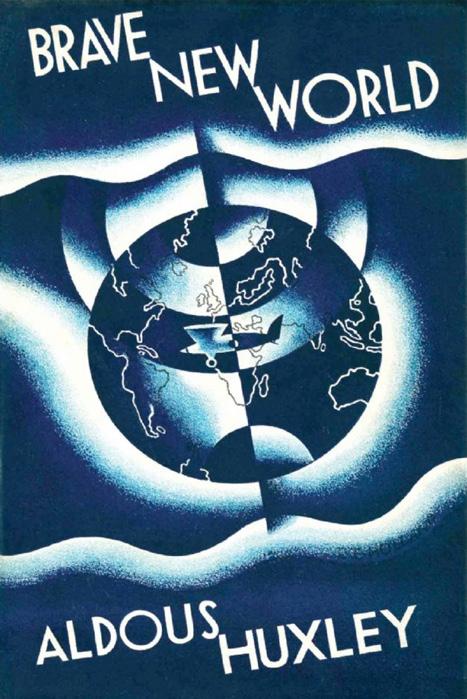
46 IN MAGAZINE JANUARY / FEBRUARY 2023
INSIGHT
Fifth Business
 by Robertson Davies - 1970
by Robertson Davies - 1970
Because he was something of a household name in Canadian book-reading households in the 1980s, I never suspected Davies of being subversive. But even the idea of a “fifth business” – the character in an opera company who is not hero nor heroine, confidant nor villain, that is, having no partner nor analogue – is inherently queer. It takes an androgynous woman to bed the novel’s otherwise asexual protagonist, Dunstan Ramsay, who is obsessed with his boyhood nemesis Boy Staunton, a man who is horny to the point of pansexuality. When Staunton is found dead, in his mouth is the stone with which he had, as a boy, killed Ramsay’s mother. In Davies’ 1981 novel Rebel Angels , the character Urquhart MacVarish likes having pink velvet ribbon shoved up his bum. For Davies, homosexuals are exotic whimsical creatures, simultaneously self-created and worldly. Are LGBTQ2+ people always more fabulous than their straight counterparts? Yes, answers Davies.
Forgetting Elena
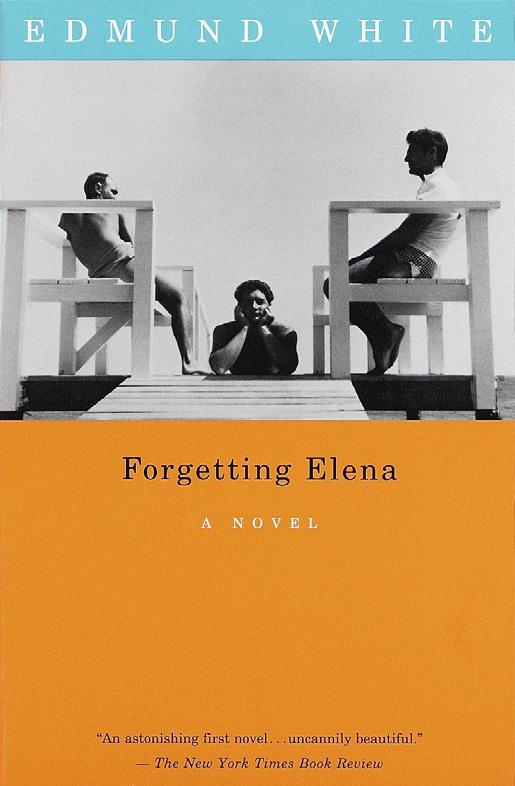 by Edmund White - 1973
by Edmund White - 1973
I had never heard of White’s classic A Boy’s Own Story when I found this waterstained novella in a usedbook bin. Though it’s set in a real place – the gay summertime playground of Fire Island – this story of an amnesiac young man trying to figure out who he is is so stylized that I took it for a fictional location, closer to Kafka’s The Castle than to places like the Pines and the Meat Rack, both of which I learned about much later.
The book feels like it’s written in code: you have to live in the world for a while to understand what’s happening. Of course, this is a great metaphor for North American gay life prior to, say, the 1990s, when a veil of secrecy hung over gay socializing and sexualizing. In the novella, after a fire becomes the talk of the community, references to it are inexplicably turned into a community performance-art piece. “A new song starts up and everyone does the ‘Fire fire who.’ I, too, crouch and lift my arms as I advance between the girls across the room. The flames waver above their bed of white stones in the night breeze infiltrating the room, trying to remind us of something.” It chronicles the inscrutability of a society to outsiders – and introduced me to the pleasures of high camp.
The Devil Finds Work by
James Baldwin - 1976
In this petite collection of essays on film, Baldwin provides an adept and angry example of the power of intersectionality to see through all of society’s bullshit, to show how the tropes of victim and honourable citizen, predator and prey, are as manufactured as any sugar pill. The idea of disloyalty as a virtue bubbles under his dissection of films like In the Heat of the Night, Guess Who’s Coming to Dinner? and Lady Sings the Blues. About My Son John, a desperately anticommunist McCarthy-era film from 1952, Baldwin wrote of one of the two adult sons of a so-called all-American family: “The moment he enters the family house, he makes the reasons for leaving it very clear: his American Legion father, his adoring mother, his football-playing brother, bore him shitless, and he simply does not want to be like them. This is heresy, of course, and [actor Robert] Walker plays it for all it is worth, absolutely heartless and hilarious, acting out all his mother’s terrors, including, and especially, the role of flaming faggot, which is his father’s terror, too.” Lesson: call bullshit on bullshit.

Sexing the Cherry by Jeanette Winterson - 1989
It’s the late 1980s now and Winterson might already be described as one of the first major out literary stars. Most readers start with her dryly witty autobiographically inspired 1985 debut Oranges Are Not the Only Fruit, which was made into a 1990 TV series. It’s a classic, and cleared the way for the likes of Dorothy Alison’s Bastard Out of Carolina and Alison Bechdel’s Fun Home But this post-modern fable-like novel is the opposite of something as true-to-life as a memoir. In Sexing the Cherry, Winterson has no interest in happily-ever-after, reconciliation, or even making clear the gender of her characters. Is it a man or a woman or someone else who is exploring a new place they have stumbled upon: “I decided to look round the place and began by going to a stall to buy some bread. The young woman behind the stall was unsmiling, though I smiled a good deal. Eventually she said, ‘What you’re doing is illegal. You should stop it.’ ‘What’s illegal?’ ‘Falling in love with me.’ ‘I’m not falling in love with you.’ ‘Why are you smiling then?’” Winterson was not simply saying: fall in love and have sex with who you want. She was saying: throw out all the rules about love and sex and who’s who, and invent your own story. As we, in our current era, figure out the role of trans and nonbinary people in our society, and scrutinize our relationships to love and sex beyond merely the genitalia of our objects of desire, Winterson might be the most prescient writer on this list.
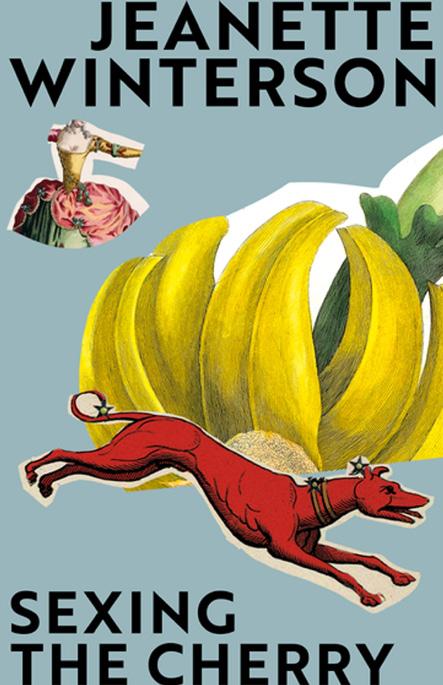
47 INSIGHT PAUL GALLANT is a Toronto-based writer and editor who writes about travel, innovation, city building, social issues (particularly LGBT issues) and business for a variety of national and international publications. He’s done time as lead editor at the loop magazine in Vancouver as well as Xtra and fab in Toronto. His debut novel, Still More Stubborn Stars, published by Acorn Press, is out now.
Party Heart-Y
At WorldPride Sydney!
Sydney hosts WorldPride 2023 with a full week of fun-in-the-sun events
By Noel Hoffman
Over a million LGBTQ travellers will be Aussie bound this February to experience WorldPride Sydney from February 26 through March 6. It is the first time the annual Pride event – with its parades, festivals and other cultural activities – will be hosted in Australia, and the timing couldn’t be better. 2023 marks the 45th anniversary of the Sydney Gay and Lesbian Mardi Gras and the fifth anniversary of marriage equality in Australia. Both are certainly causes for celebration, and the city is doing it in grand style!
Daywash Events, Sydney’s premiere gay party organizer, will present six massive official Pride Amplified extravaganzas, including Candyland XXL and the Circuit Festival Waterpark Day at Raging Waters amusement park. All parties will feature live acts, stunning decor (including laser and light shows), and performances by some of the world’s most famous international circuit DJs. A portion of
“Daywash parties are always over-the-top spectaculars but in celebration of Sydney’s WorldPride, we are going even bigger and better than ever before,” says producer Johan Khoury. “We are also partnering with the largest international circuit festivals to produce a week unlike anything anyone has seen.”
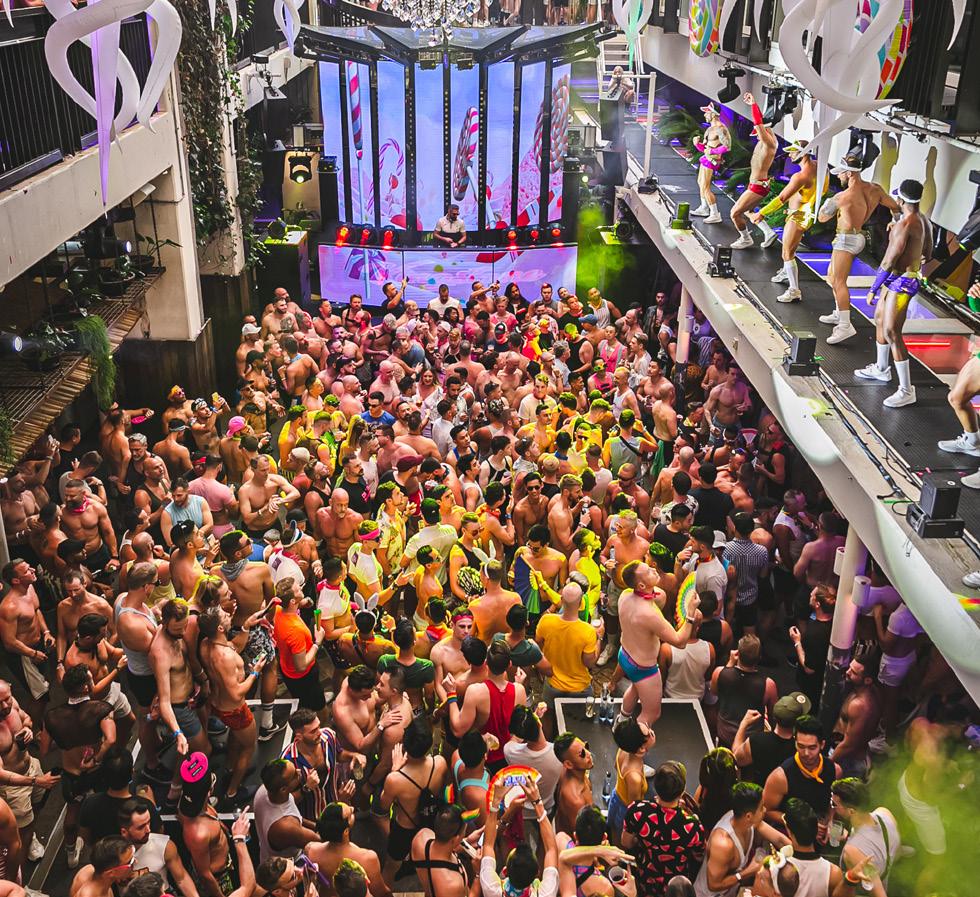
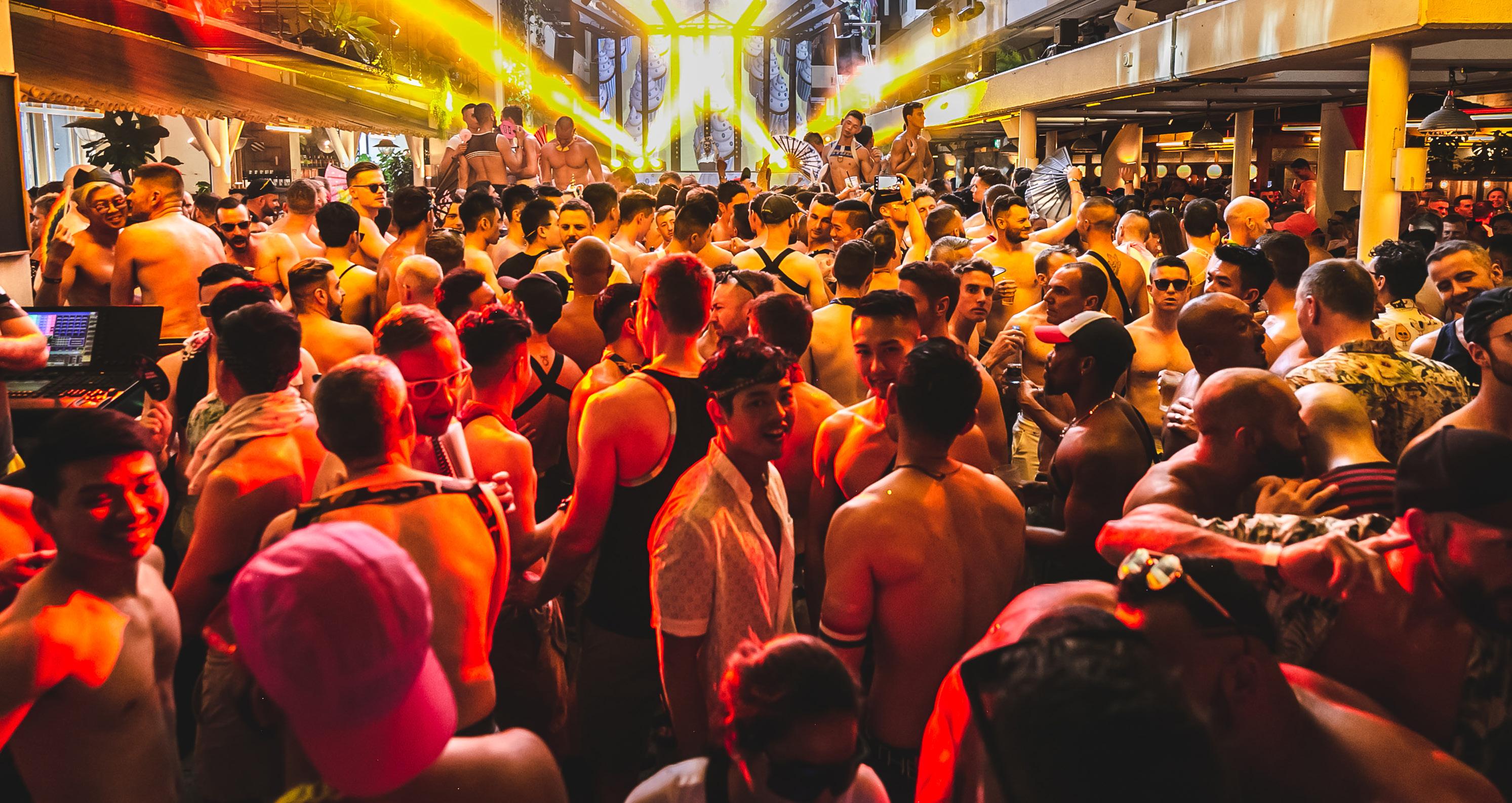
“Guapo Fiesta” kicks off the week’s festivities on Sunday, February 26. Dubbed São Paulo’s sexiest party, this will be Guapo Fiesta’s Sydney premiere. It will take place at The Argyle, a colossal venue with multiple rooms that will offer the thousands of attendees a range of chill and flirt zones, and will feature a sensational DJ lineup including Brazil’s Rafael Berreto and resident superstar Mario Backman.
The next morning, the fun moves to The Ivy Club for Candyland XXL, the week’s first outdoor afternoon event. Candyland is a signature Daywash party and always a crowd favourite. For WorldPride, partygoers will be treated to a double extra-large dose of the event. Upon entering, the scenic decor will make guests feel like they have entered a magical candy factory. Rainbow-coloured popcorn, fairy floss and flavoured snow cones will be served for free at multiple candy stations. The evening will also include jaw-dropping performances, delicious go-go boys and DJs Dani Toro (from Spain) and José Rendón (from Dublin) spinning the dance floor until 10 pm.
Tuesday and Wednesday will be days of rest and recovery. LGBTQ+ travellers may use this time to visit the local sights, including The Opera House, the Sydney Harbour Bridge and the Taronga Zoo. Plan to spend a day at one of Sydney’s beautiful beaches: Bondi Beach is the most popular. A Sydney Harbour cruise is also a must, as is the Aboriginal Dreaming Tour, where visitors will learn about the culture of Aboriginal people.
the proceeds from all Pride Amplified and Daywash events will benefit programs including ACON (AIDS Council Of New South Wales), the Olivia Newton-John Cancer Wellness Program and Father Riley’s Youth Off the Streets.
The party picks up again on Thursday, when Brazilian adult performer Diego Barros makes his Sydney debut at Anaconda. Known as the ‘Magic Mike’ of Brazil, Barros is often called one of the world’s sexiest men. He has over one million followers on Instagram, and a very popular OnlyFans page. He will perform two nude shows plus a meet-and-greet. Between performances,
48 IN MAGAZINE JANUARY / FEBRUARY 2023
PRIDE
Photos courtesy of Daywash Events
On Friday, Daywash partners with the world’s biggest gay party producer, Matinée, to host the Daywash Circuit Festival Waterpark Pre-Party Sydney 2023, taking place at the Raging Waters amusement park in Sydney. The entire park will be closed to the public and open exclusively for Daywash attendees. Guests will be able to enjoy all the rip-roaring rides and attractions, including Sydney’s largest water slide, without the long lines. Two dance floors will be set up on the grounds. Matinée resident DJs Phil Romano and Dani Toro will headline the main stage at the Beach Wave Pool Main stage. A second stage will be set up at Dinosaur Lagoon. VIP cabanas and party buses are available as special luxury adds-ons.
The Friday fun continues when Daywash and Matinée regroup for a second phenomenal adventure, The Temple of La Lecha White Party. Matinée superstar DJs Kingstone (from Paris) and Liza Rodriguez (from Brazil) take over the indoor and outdoor stages. Matinée promises a level of production that is above and beyond anything seen before, with laser and light shows and the crème de la crème of sexy international go-go dancers.
On Saturday night, the iconic Sydney venue, Kinselas, hosts an Arab night! All four levels of Kinselas will be open to partiers for the “Club Arak” event. The Chapel underground will pay homage to Arab divas with live musical performances. The street-level basement bar will be a chill-out space with amazing Arab tunes and drinks. The middle bar will be the women’s space and the top level will be the main dance floor, where DJ Chadi will be spinning the latest and greatest of Arab dance grooves.
Then, on Sunday, daddies, leather men, shirtless boys, bearded hotties and everyone in between will converge at the RAM party. Hosted by Daddy Ersin, RAM was born and bred in New York City’s underground club scene and has toured the biggest gay cities around the world, selling out venues at San Francisco’s Folsom Party, Dallas Pride, and more. Rules don’t apply on the RAM dance floor as the vibe is extra-cruisy with unfiltered testosterone. Resident USA DJ Joe Pacheco, popular for his thick and thirsty beats, will headline.
The week wraps on Monday, March 6, with the Kiki Gay Pool Party Finale, taking place at The Ivy pool. Set high above the bustling streets with the gorgeous Sydney skyline as backdrop, the pool party will be the perfect way to wind down the week’s festivities. There will be surprise pop-up DJs and performers, VIP cabanas, bottle service and additional special luxury add-ons.
Tickets for Sydney WorldPride 2023 Daywash events – including VIP and all-access party passes – are available now at Daywash.com.au.


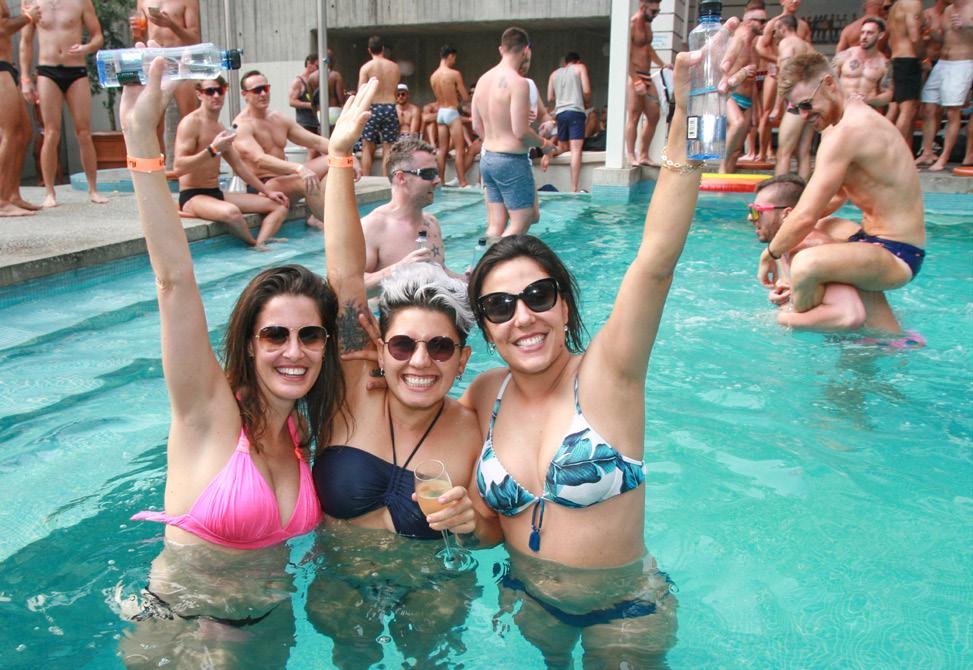

49
DJ Rafael Barreto will keep the dance floor moving with his highenergy Brazilian beats.
PRIDE
Exclusive In Papagayo
A deluxe experience in northern Costa Rica reveals Pacific vistas, detailed hospitality and wide-open wilderness
 By Doug Wallace
By Doug Wallace
There’s a coconut on the dining room table with a straw in it – and my name burnt into it, like pyrography. Valentina, the Exclusive Resorts concierge, is showing us around the villa that will be our home for the week, while a welcoming team offers a rum punch and a bowl of heavenly ceviche. The fridge is full of precisely everything I had requested in advance – check and check. A valet lurks in the hallway, ready to ferry our bags to whichever room we select. This is how Posh and Becks live, I think.
We’re on the tip of Peninsula Papagayo in Guanacaste, the northern province of Costa Rica, high on a hill overlooking Culebra Bay. I’ve been here before and couldn’t wait to return. There’s just something about the black-sand beach, the red gumbo-limbo trees and the unfamiliar calls of exotic birds that makes me feel like I’ve stepped into an episode of Wild Kingdom
Turns out I’m not that attuned to the critters. When the welcoming committee departs, the first thing I do is scare away a little capuchin monkey – just as my partner is about to snap his picture. Oops. The wee white-faced guy has leapt onto the balcony to check us out, a little too quickly for my liking, so I panic and clap my hands. I’m remembering Valentina’s tip that the capuchins have figured out how to get into the condo through the outdoor shower doors – which, thankfully, lock.
As the monkey retreats, we see a raccoon-like coati poking about the base of the villa. He’s a big one, with a giant ass and a shiny coat, looking for tasty tree litter, maybe a rodent or a lizard or two. This

woodsy welcome is all part of the experience in Papagayo, one of Costa Rica’s top luxury hot spots, a wonderland of seven beaches, tropical dry forest and private villas. The nearby Liberia airport sees regular traffic from Hollywood celebrities, who sequester in the nearby Four Seasons or the Andaz, play golf at an Arnold Palmer course or hop on a yacht in the Papagayo Marina, the largest in the country.
Yet despite the grandeur, wilderness prevails. Peninsula Papagayo’s 20 kilometres of nature trails reveal a land of diversity – open mesas, old-growth mangrove preserves, coral reefs – plus the aforementioned 240 different mammals, 850 species of birds (including toucans and the protected and highly intelligent scarlet macaw), plus 1,500 kinds of orchids.
Tapping into nature is easy: it completely surrounds me. Government rules dictate that 70 per cent of the peninsula must remain natural. A 40-kilometre-per-hour speed limit slows everyone down, so you’re not running over monkeys, and roadside reflectors sub in for streetlights, in accordance with light-pollution laws. It’s like we’ve come upon our own little private forest, albeit one peppered with beach clubs.
Trend alert: Privacy is the new luxury, unsurprisingly, given the last couple of sequestered years. The aptly named Exclusive Resorts operates like a private travel club, where members pay a fee for access to a portfolio of 350 private residences in more than 75 countries. The “exclusive” part comes in the form of exemplary service. At Exclusive Papagayo, Valentina has not only filled the fridge, but she has also
51 TRAVEL
Howler Monkeys (Photo courtesy of Costa Rica Tourism)
booked us an in-villa dinner with a private chef, made a reservation for us down the road at Poro Poro Restaurant – for sushi night! – imparted directions on the hiking trails and arranged for a mixologist to pop in one cocktail hour to teach us how to shake up some drinks. Five, in fact. Dinner’s gonna be late.
Nice as it is, we actually leave the compound
Home to everything from sandy beaches to dry forests to protected wetlands, the northwestern Guanacaste region plays an excellent host. Finding a natural balance between sitting on our asses and unbridled activity is the plan. With the variety of sporty things to do in Guanacaste, thanks to the diverse terrain, you can easily come home slimmer than when you arrived.

You don’t have to drive far to experience canyoning, zip lining, mountain biking, rock climbing or horseback riding. The list of watersports is almost as long, and includes the full paddling pastimes, snorkelling and diving, plus waterfall rappelling and river tubing. On the other side of our bay, the Pacific coastline stretching south is dotted with beach towns – some super-quiet, others party-central, teeming with surfboards, beach bars and condo rentals.
On the peninsula, the hiking and biking trails weave around parts of the golf course, all the way to the marina. We bust our calves one morning, not on a path, but on a stairway trail that is strewn along the hillside between two beaches. We stop at the Four Seasons beach for a swim and a chat with some of the guests out walking on the sand. All beaches are public in Costa Rica, the neutral space reaching inland 50 metres from high tide, so access trails are all well-marked.
We manage to celebrate the fact that we’ve taken some exercise at Prieta Beach Club, to which we have access as Exclusive guests, sitting down for a well-deserved lunch, before repairing to a beach cabana. We daydream for a while, watching a quartet of buff guys boogie board the waves for a while, their hair-tossing skills on par with the top fitness models. I’m never leaving, I think.
Back at the villa, my calves find some relief in the jets of the hot tub. It threatens rain, and the howler monkeys are perturbed. Their growling tapers off as they retreat for shelter. I wonder where my white-faced monkey ended up. He never came back – unless he made his way in through the shower and is hiding somewhere.
52 IN MAGAZINE JANUARY / FEBRUARY 2023
DOUG WALLACE is an international travel and lifestyle writer, photographer and custom-content authority, principal of Wallace Media and editor-publisher of TravelRight.Today. He can be found beside buffet tables, on massage tables and table-hopping around the world.
TRAVEL
Papagayo (Photo courtesy of Costa Rica Tourism)
KAYOOT
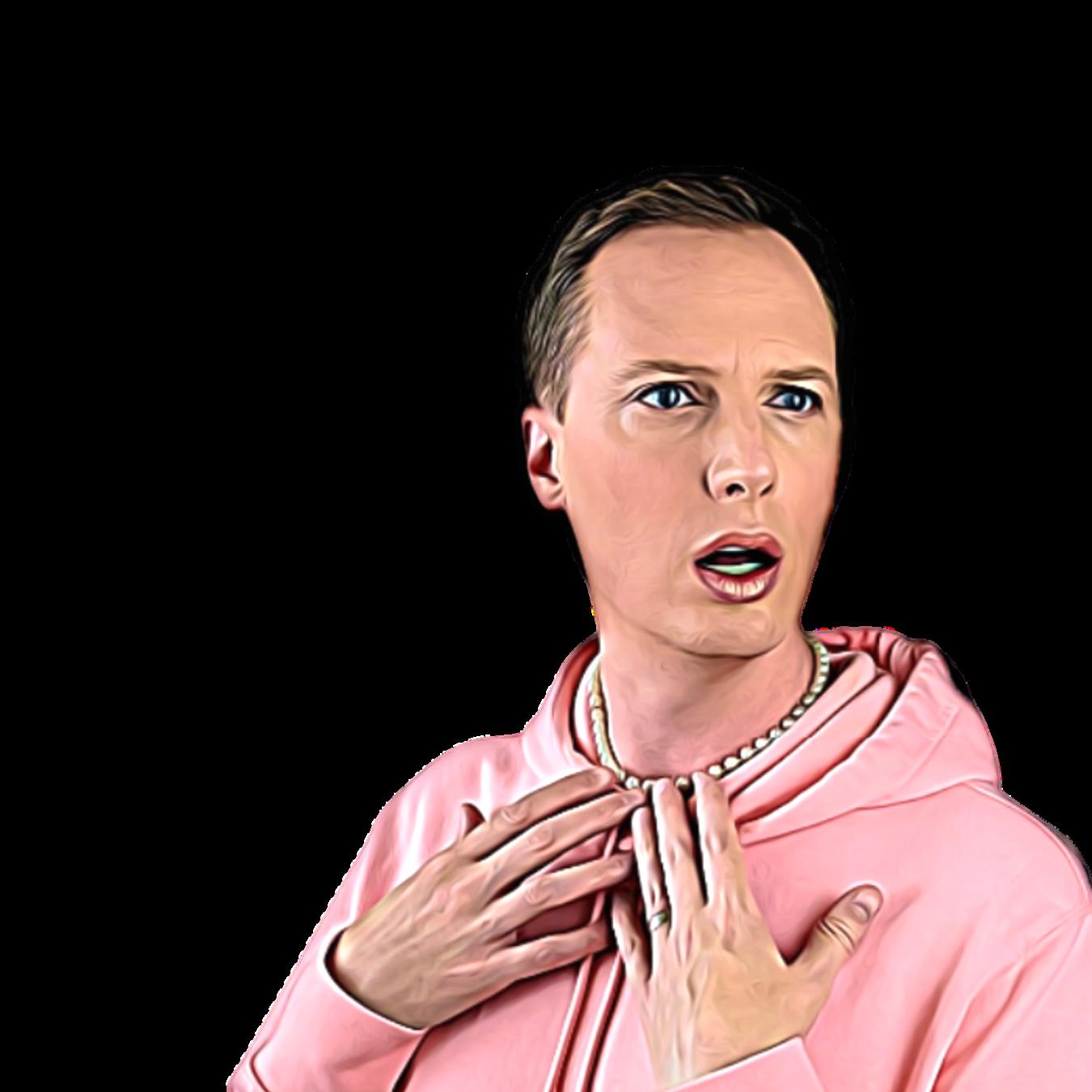

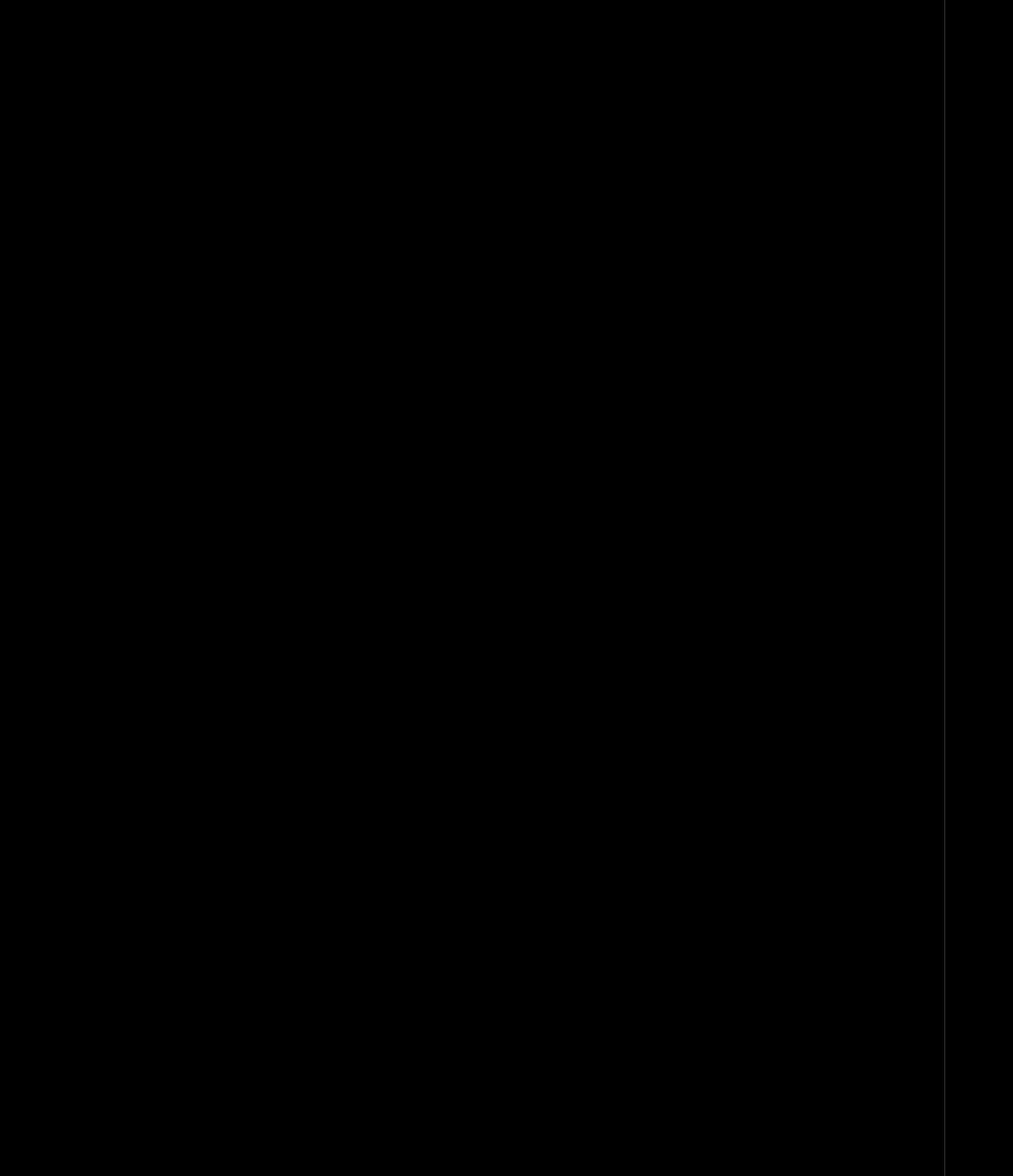











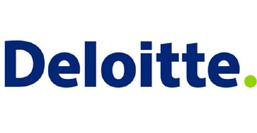

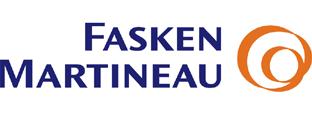
Let’s just say that these will boost your outfits up at least 3 levels of chic, get no less than 5 mentions a day, and all of the attention in the room. hehe ;-)
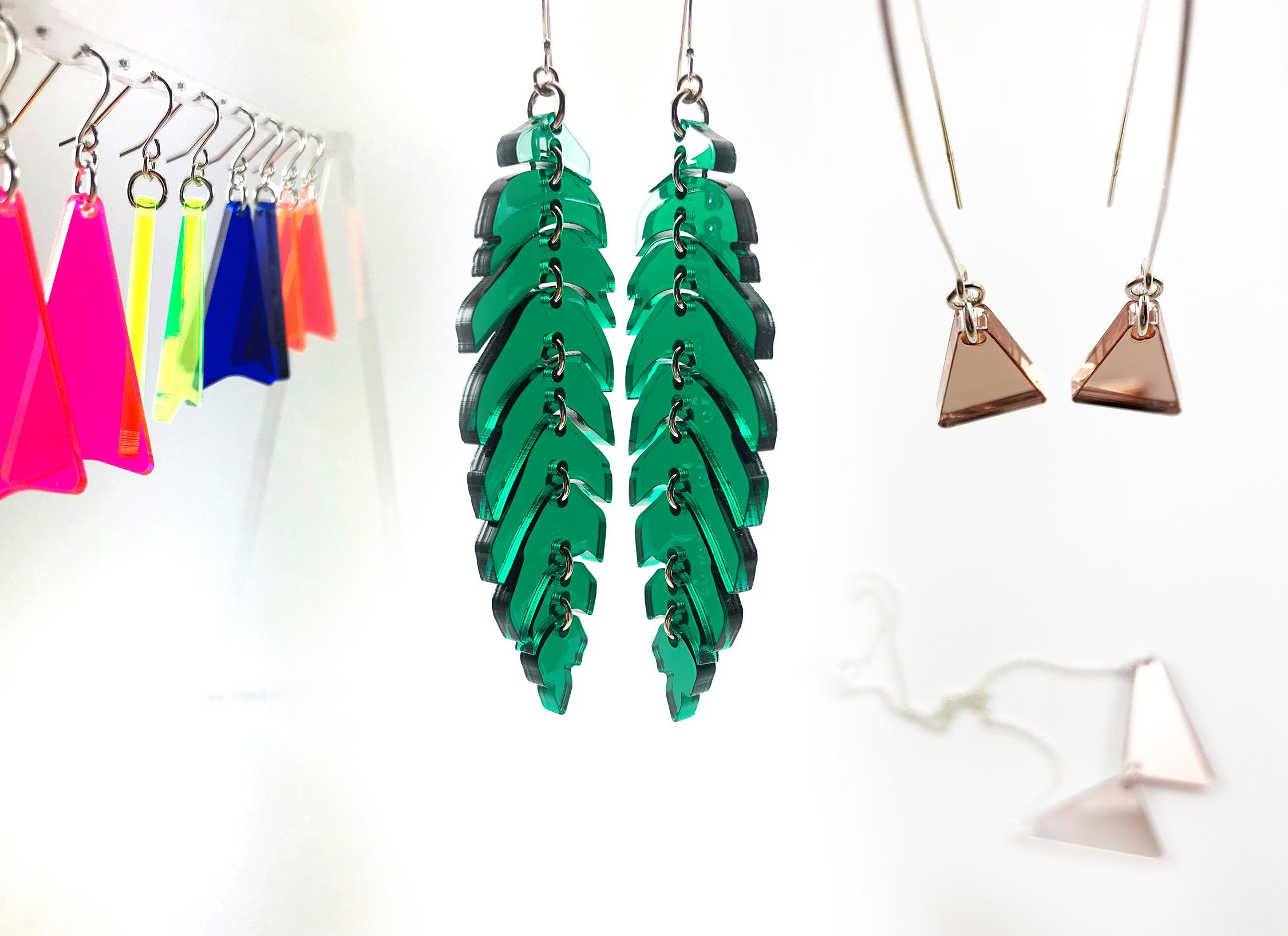
O M O W d R W
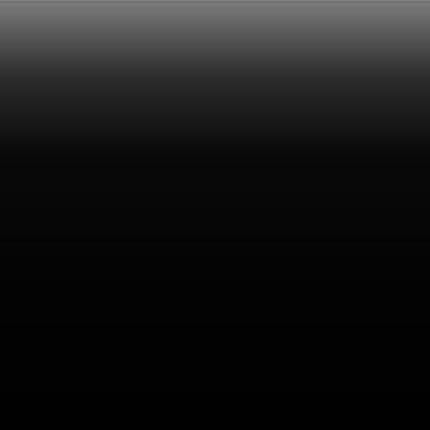


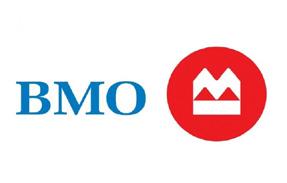
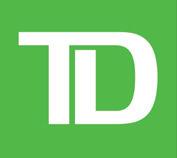
info@KAYOOT.ca
H
These earrings are constructed using high precision laser cutting. Being only 3 mm thick, they are super lightweight. They are made from high quality acrylic and 925 sterling silver. l i v e a t t h e r i v o l i A V A I L A B L E 0 1 . 2 7 . 2 0 2 3 p r e v i e w i t n o w a t l i n k t r . e e / g a y a f c o m e d y
FLASHBACK
Svend Robinson Becomes Canada’s First Member Of Parliament To Come Out As Gay (February 29, 1988)

On February 29, 1988, Svend Robinson became the first Canadian Member of Parliament to come out as gay. He was the only openly LGBTQ2 member of the House of Commons until 1994, when Bloc Québécois MP Réal Ménard came out as gay.
Robinson is now retired. But 35 years ago, when he became the first MP to come out as gay, Canada was battling the HIV/ AIDS crisis. Fear of the disease, coupled with long-standing social stereotypes, meant homophobia was rampant across the country.
Robinson was only 27 years old when he began his political career in 1979, being elected to represent the suburban Vancouver-area constituency of Burnaby for the New
Democratic Party (NDP). On February 29, 1988, he sat down with CBC reporter Barbara Frum and told her he was gay.
“Nobody had ever done it before, and many people said this was political suicide,” Robinson recalled in 2018.
Thankfully, it wasn’t political suicide, and Robinson was re-elected six months after he came out, winning by a larger margin than he’d ever had before. He remained in office for another 16 years, before deciding not to run in the June 2004 election. At the time, he was one of the longest-serving members in the House of Commons, having been elected and re-elected for seven consecutive terms.
54 IN MAGAZINE JANUARY / FEBRUARY 2023


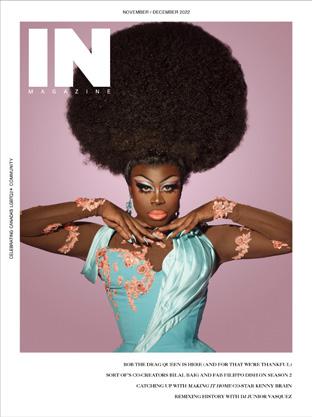
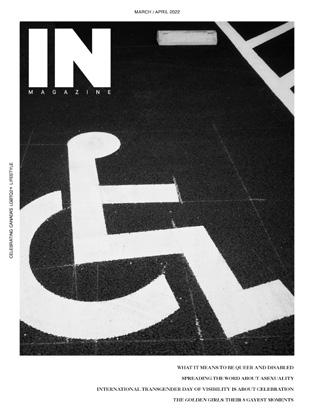




56 IN MAGAZINE JANUARY / FEBRUARY 2023 inmagazine.ca INMagazineCA PUBLISHED BI-MONTHLY ONLINE CONTENT EVERY DAY IN MAGAZINE IS CANADA’S LEADING LGBTQ2+ DIGITAL PUBLICATION, WEBSITE AND COMMUNITY PLATFORM

















 By Luis Augusto Nobre
By Luis Augusto Nobre
 By Adriana Ermter
By Adriana Ermter

 By Casey Williams
By Casey Williams






 By Matthew Creith
By Matthew Creith





 By Elio Iannacci
By Elio Iannacci




 By Christopher Turner
By Christopher Turner

 Photo by Dannyson Pham
Photo by Dannyson Pham











 by Robertson Davies - 1970
by Robertson Davies - 1970
 by Edmund White - 1973
by Edmund White - 1973








 By Doug Wallace
By Doug Wallace









































